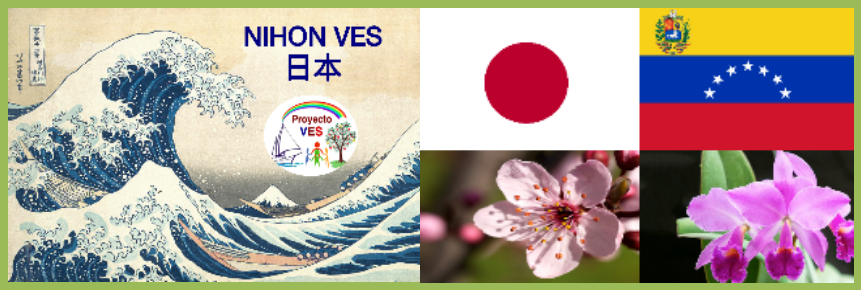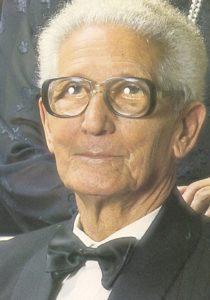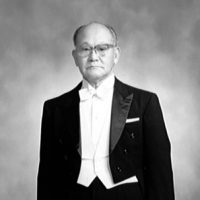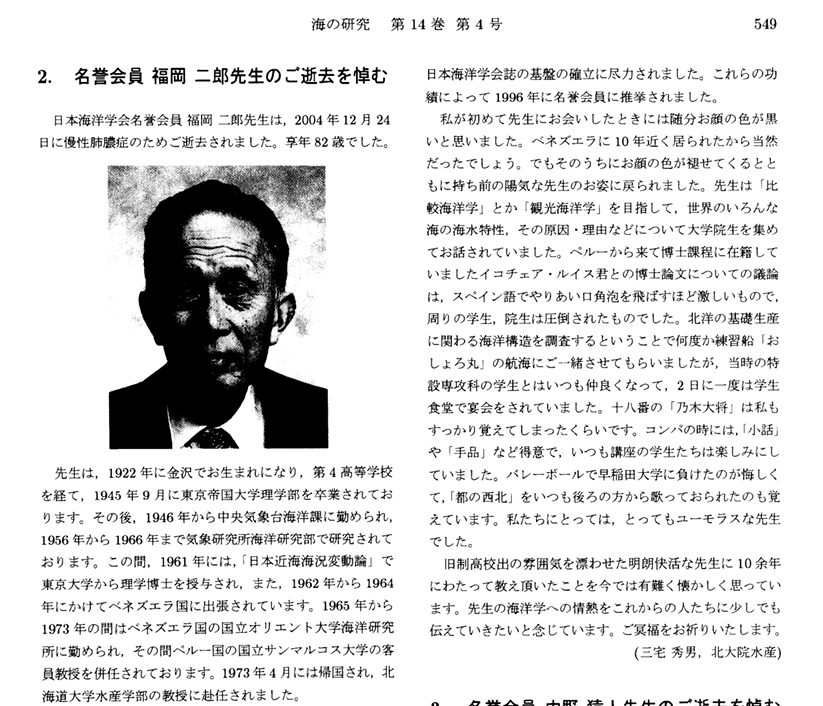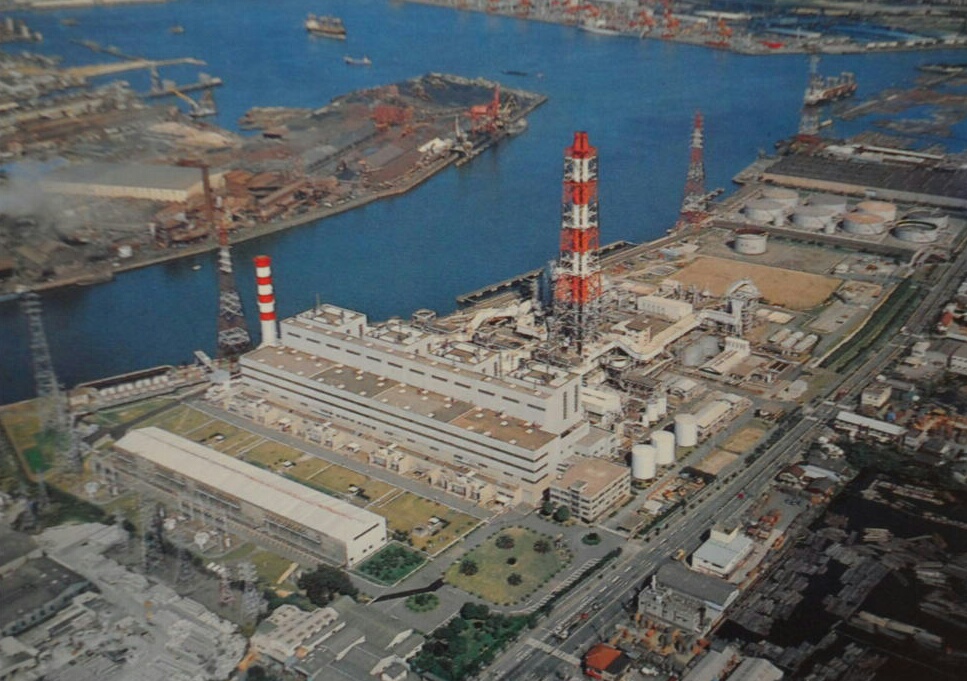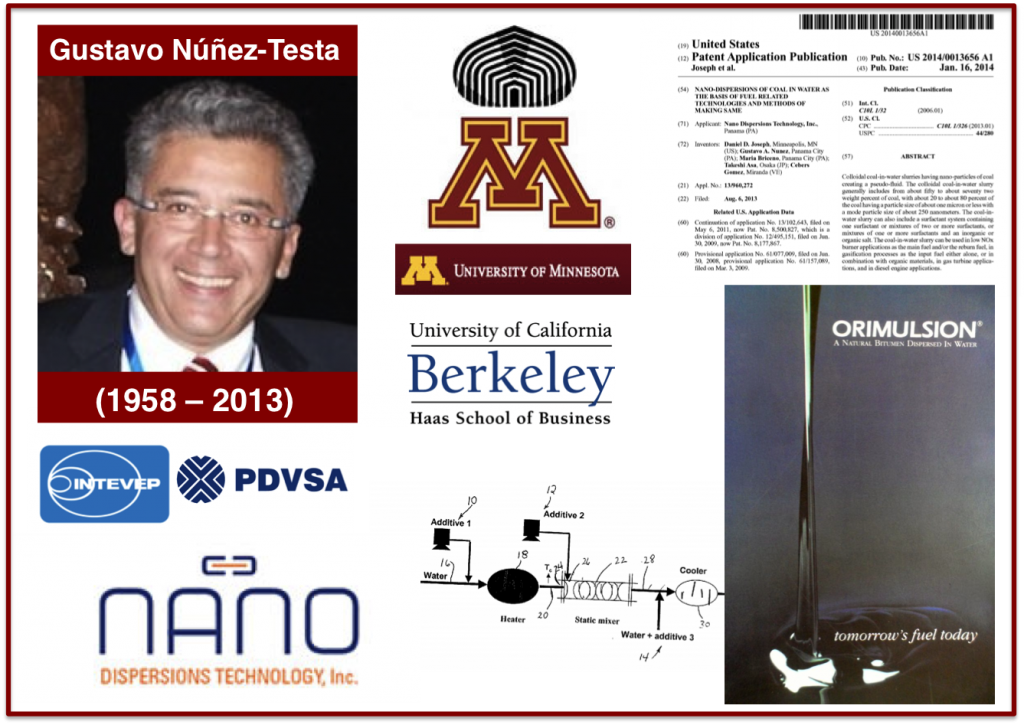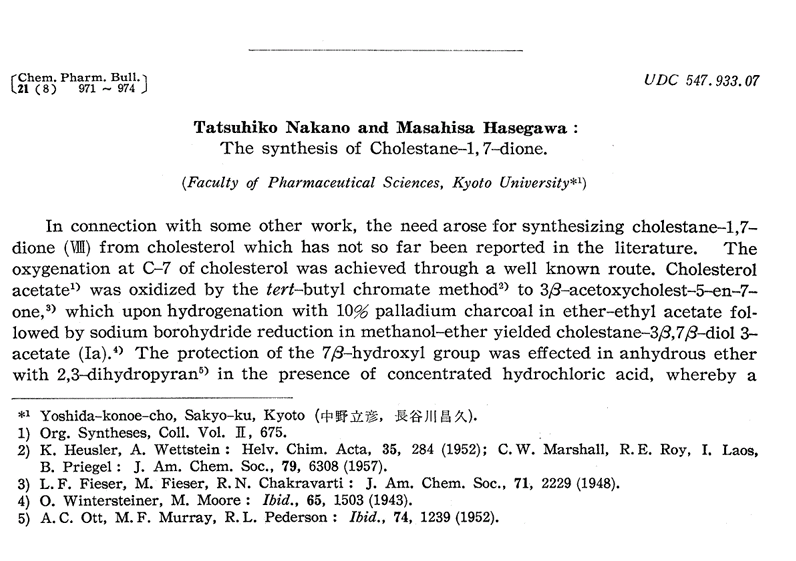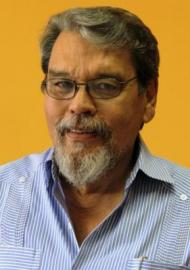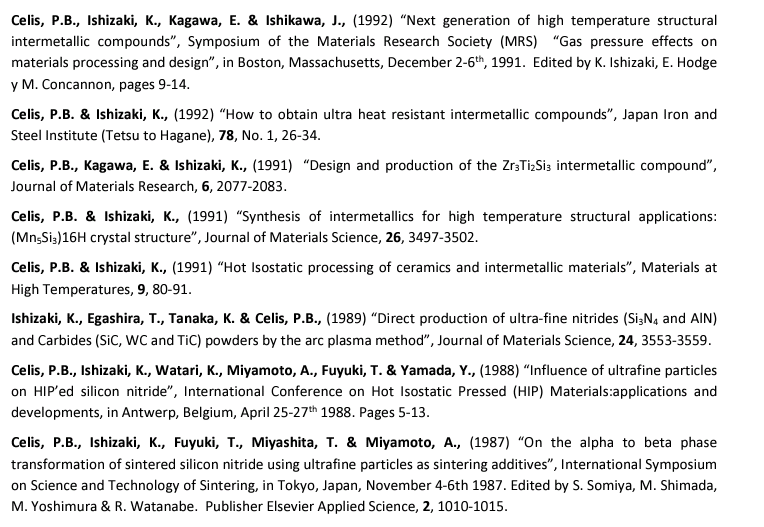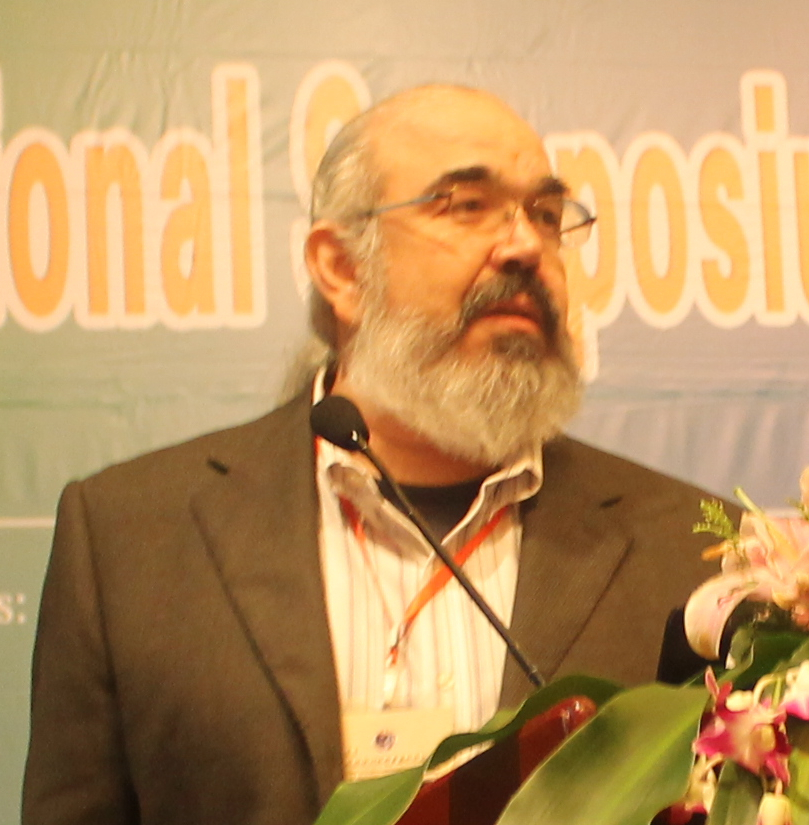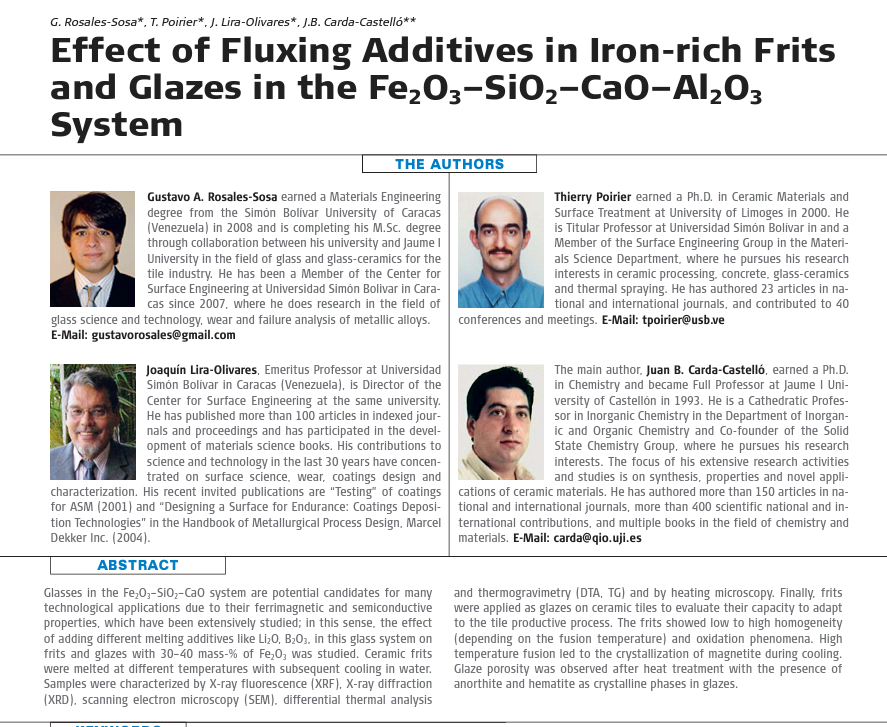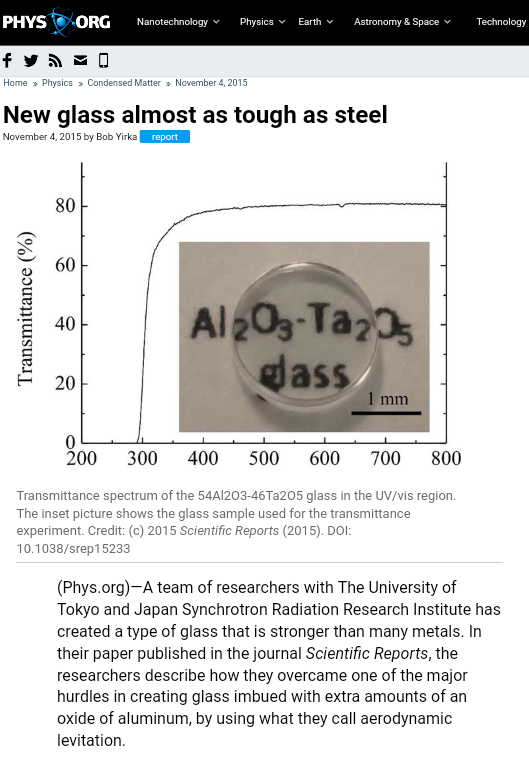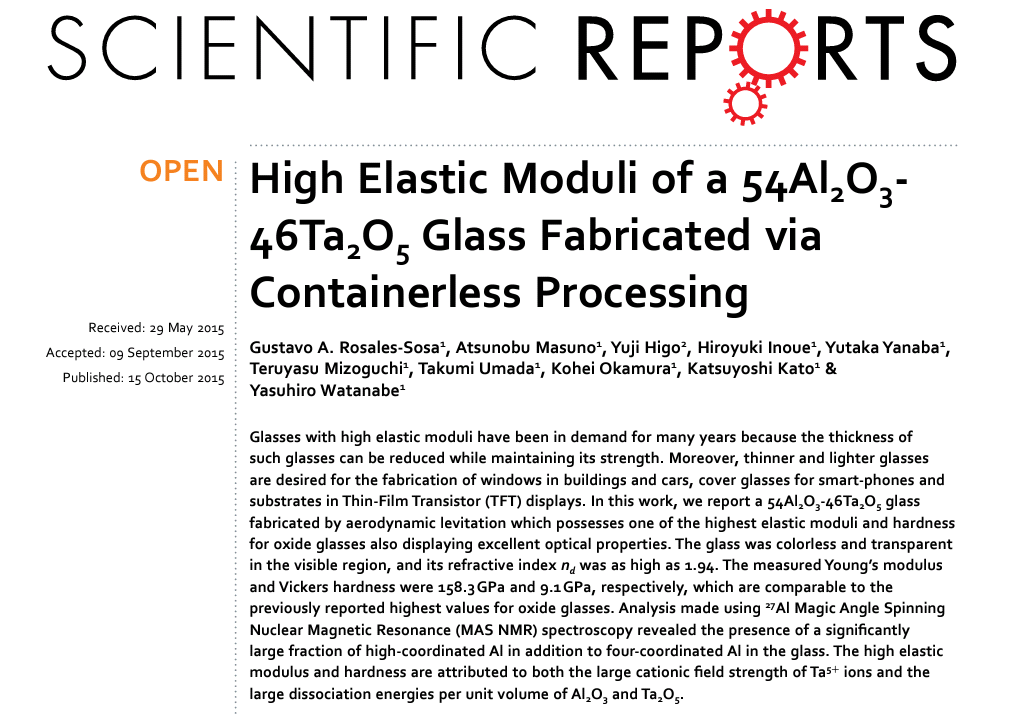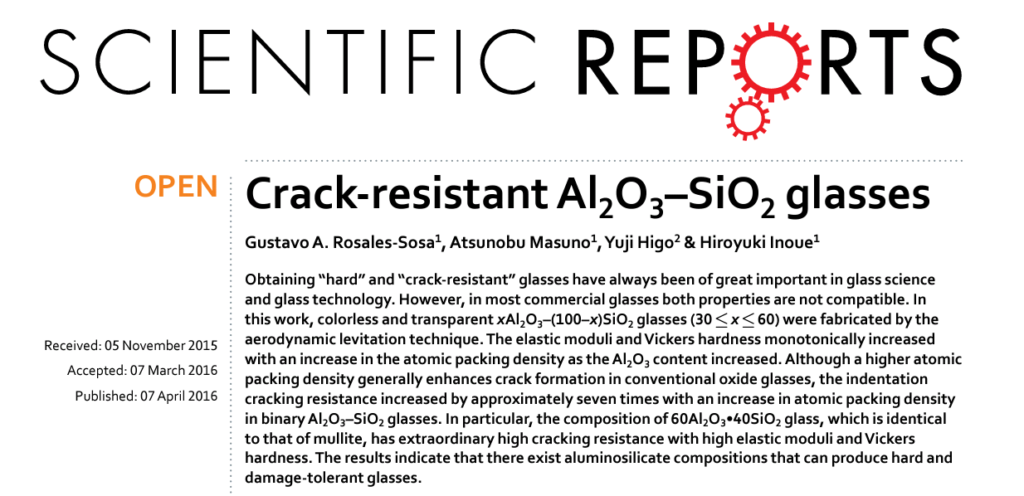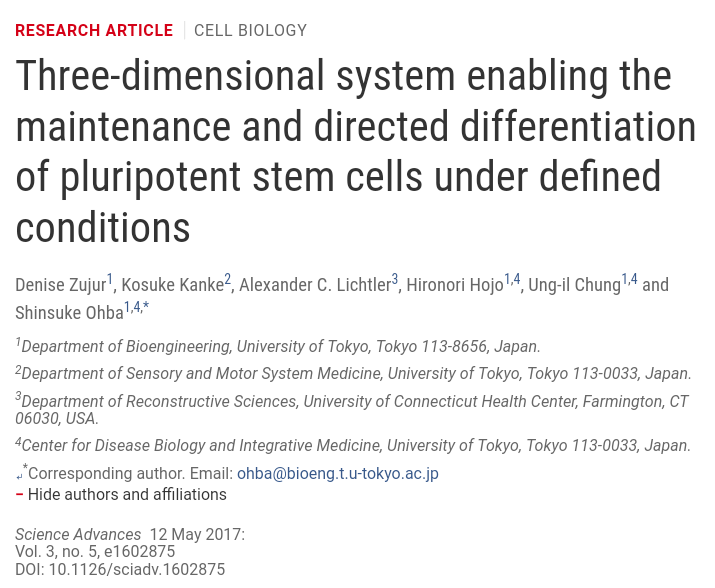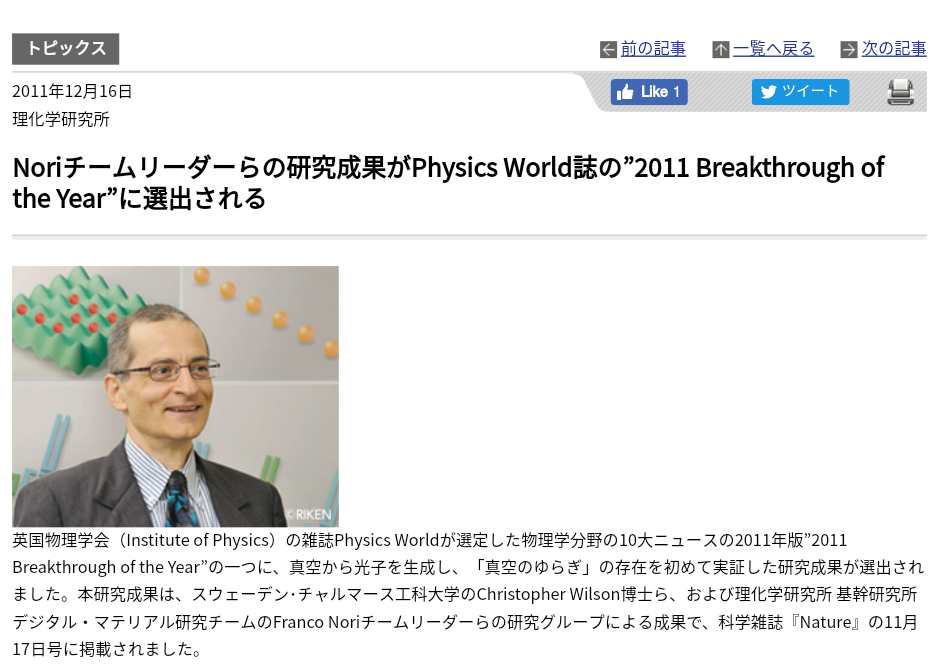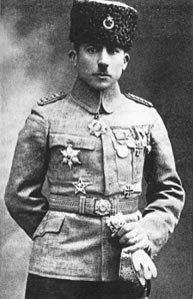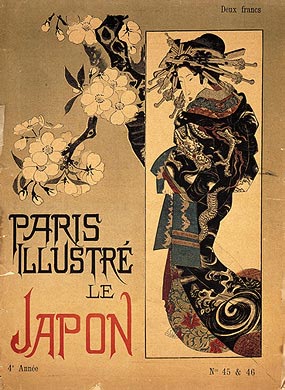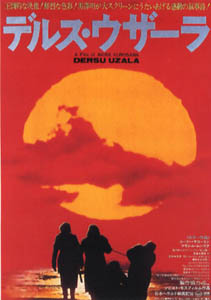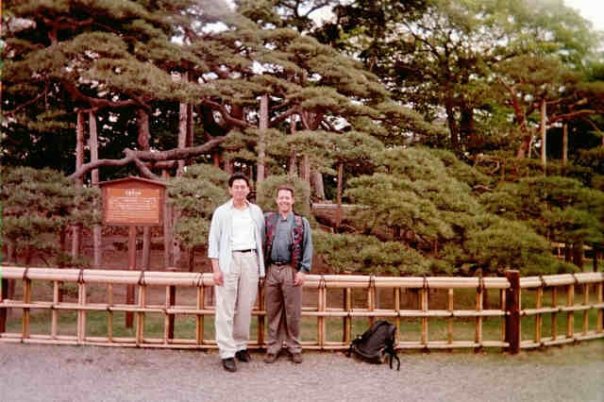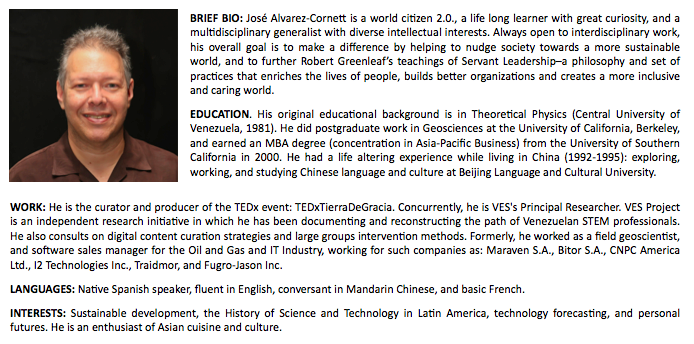PROYECTO VES PROJECT
José Álvarez-Cornett
(@chegoyo en Twitter)
CARACAS (Chegoyo.com)
December 20th, 2017
Dedicated to:
Dr. Jack Gustaf Lewis,
former Director of IBEAR and Associate Dean (retired) of the
University of Southern California, IBEAR MBA program.
For his support and sincere concern for Venezuelans and,
in particular, for Venezuelan IBEAR MBA alumni.
While attending Lewis & Clark College for his undergraduated degree,
Jack Lewis developed an interest in Asia and, in particular, in Japan.
Later, he completed his Ph.D. at Stanford University
in Comparative and Japanese Politics.
Thank you, Jack!
The annals of the Venezuelan history of science and technology hide a beautiful story. Metaphorically speaking, it’s like a fragrant but hidden garden of cherry – sakura– trees and orchids that is yet to be discovered. Our desire is to search for this secluded garden, find it, describe it, and chronicle it so as to unravel its nature and make it manifest, that is, public. With this work we also want to nurture the spirit of the Venezuelan youth of today and of future generations.
But, really, what is it all about? In VES Project we have created a new line of research to dig up the soils of migration history to tell the story of the contributions to science and technology made in Venezuela by a small group of Japanese scientists and technologists, mainly during the second half of the 20th century. But, oh, what a surprise!, we also want to investigate to tell a present-day but unknown story about several Venezuelan scientists and engineers already integrated into Japanese society and of their contributions to science and technology in Japan. The Venezuelan diaspora, although small, is spread all over the world! This new line of research has been named NIHON VES.
VES Project is an independent research initiative created in 2013 to study the life profiles of the techno-scientific migration in Venezuela. Meaning, the immigration of foreign scientists and engineers to Venezuela from 1935-1985 and the recent emigration of Venezuelan scientists and engineers to other countries from late 1970’s until today (to name but a few, people like Rafael Reif, President of Massachusetts Institute of Technology (MIT), who is a Venezuelan Electrical Engineer; Cristina Amon, Dean of the Faculty of Applied Science at the University of Toronto, who is a Venezuelan Mechanical Engineer; Mario Vecchi, who had a successful professional career as an applied scientist with Bell Labs and, today is the Chief Technology Officer (CTO) of the Public Broadcasting System (PBS); and, among many others, Venezuelan economist Ricardo Hausmann, the Director of Harvard’s Center for International Development.) We created NIHON VES because the immigration of Asian scientists to Venezuela, and, in particular, of Japanese scientists, has hardly been studied.
VES is a Spanish acronym with a double meaning. When it refers to the emigration of Venezuelans overseas, VES means: Viajaron, Emigraron y Surgieron (they Traveled, Emigrated and Succeeded.) But when it refers to the immigration into Venezuela of scientists and technologists, VES means: Vinieron, Educaron y Sembraron (they Came, Taught and Sowed.)
We already have clues on how and where to find this secret garden of cherry trees and orchids. In our preliminary studies to establish this new line of research, we discovered that Japanese in Venezuela have contributed to several scientific and technological fields: marine sciences (oceanography and fisheries), food science, chemistry of natural products, biophysics, biomedicine, mathematics, material science, metallurgy (steel and aluminum), oil and gas (in particular, technological developments related to the production and combustion of a Venezuelan high tech fuel emulsion called Orimulsion® and gas production technologies), telecommunication, and risk analysis and disaster prevention.
However, for the time being, the main objective of NIHON VES is to study (1) the life profiles of those Japanese immigrants who have contributed to the development of the physico-mathematical sciences in Venezuela (here, ‘physico-mathematical’ is a term to be understood broadly to include engineering aspects), and (2) the life profiles of Venezuelan scientists living in Japan (they are active researchers in physics and material science.) But, with NIHON VES, we also want to study the collaborations between Venezuelan and Japanese research laboratories, and take a look at the education in Japan of hundreds of Venezuelan scientists and engineers.
To provide context to our research, in this essay we will briefly review how the diplomatic relations between Venezuela and Japan began, how the first Japanese immigrants came to land in Venezuela, and we will put forth our hypothesis about who could have been the first Venezuelans to ever meet a Japanese national.
In VES Project, we think it is very important that Venezuelan society and, in particular, its younger members know about how the immigration of foreign professionals and intellectuals helped to shape the development of the Venezuelan scientific establishment and the institutionalization of science in this country. We also want to offer to the Venezuelan society a set of role models and, in particular, with our NIHON VES initiative, role models sourced from a Japanese view of the world.
In 2018, Japan and Venezuela will celebrate the 80th anniversary of the establishment of bilateral relations and the 90th anniversary of the Japanese emigration to Venezuela. With the findings of NIHON VES, we can add richness and depth to the relations between two peoples: the Venezuelans who treasure orchids as their official flower and the Japanese people who have the cherry blossom as its most beloved flower, although the chrysanthemum, the imperial flower, is the official one. With NIHON VES we also want to give our small contribution to these forthcoming Japanese-Venezuelan celebrations.

On the left, a cherry tree flower (Prunus serrulata) – sakura, in Japanese – and, on the right side, an orchid (Cattleya mossiae).
What is the main take away from reading this essay?
First of all, that there is a fascinating story of immigration of people from both countries waiting to be told, and that the relations in science and technology have been profitable for both nations: the country of the orchids loving people and the nation of cherry flower lovers. In other words, that Venezuela and Japan are complementary countries. Second, up until now, our preliminary research has identified fifteen Japanese scientists and engineers who have done scientific research or technological work in Venezuela. However, if we take into account the engineers who have worked in the Venezuelan industries (steel, aluminum, automotive, oil and gas, generation of electrical energy and, perhaps, in some aspect of the commercialization of medical equipment), the Japanese scientists and technologists who have lived in Venezuela should add to several dozen. This, by the way, is topic that the historians of science and technology in Venezuela have not yet addressed. Our NIHON VES research line will attempt to study in depth the life profiles of five of these fifteen identified Japanese professionals. Third, that there is a handful of Venezuelans scientists who do or have done scientific and technological research in Japan (some were doctoral students at Japanese universities, others are university professors or leaders of research groups and some others do research work for Japanese companies and universities). Fourth, for several years, from 1988 to approximately 2007, Venezuela exported to Japan a high technology product such as Orimulsion®. Fifth, that there is an ongoing collaboration between universities and research laboratories in both countries and that more than 700 Venezuelan scientists and engineers have been trained or educated in Japan. And finally, that thanks to this exchange of people: Venezuelans in Japan and Japanese in Venezuela, the world became a little bit better.
These immigrants made history, we just want to research their life profiles and write the story of their work. Here, I invite you to read a tale which can be considered the pilot episode of a saga yet to be produced. Our preliminary findings show that much remains to be investigated, and this essay (which is a version of a piece originally written in Spanish) only opens the way.
Today, we bring to you an account of the main antecedents of this story. We will tell you about the clues we have unearthed which need to be investigated in depth to unravel the mysteries of this garden of cherry trees and orchids. However, to carry out this research project by applying our Digital Historical Sounding methodology, which we developed to use Internet and social media to search for digital fragments to do historical research online, requires many hours of work and VES Project is an independent research initiative that sorely needs funding to be able to continue researching the life profiles of many migrant scientists in Venezuela.
Additionally, we should bear in mind that this research work is being carried out under hardship circumstances because Venezuela is undergoing an economical and political crises that has lead to political violence and shortages of food and medicine. Because in Venezuela everyone is striving to survive, the peaceful conditions necessary for research are absent and, today, the country is a harsh and arid landscape for everything related to academic research. Therefore, we ask for your help.
If you like VES Project and our NIHON VES initiative, and you want to support this research to unravel the history of a Japanese-Venezuelan knowledge garden, you can use PayPal to make a donation by clicking on the DONATE button shown below.
Thanks for considering this donation request!
(1) Some Historical Facts about the First Japanese Immigration to Venezuela and the Beginning of Diplomatic Relations Between Japan and Venezuela
The immigration of Japanese scientists to Venezuela took place in the early sixties of the 20th century. However, as we shall soon see, relations between Venezuelans and Japanese are much older. The first Japanese immigrant to Venezuela landed in 1928. According to official tradition, formal diplomatic relations between the two countries began on August 19th, 1938 (some political scientists and diplomats do not quite agree on this date but we will not go into details), diplomatic relations were broken on December 31st, 1941 and reestablished in 1952. The first recorded contact between a Venezuelan and a Japanese occurred, in 1904, during the Russo–Japanese War over rival ambitions in Manchuria and Korea. However, we will later put forward one hypothesis that could push this date back to 1867 or 1878. As of 2016, 409 Japanese nationals reside in Venezuela and the number of Japanese descendants is estimated to be about 820 people (Japanese Embassy data.)
When the English-speaking countries receiving immigration finally closed their doors to Japanese emigrants, they turned to Latin America. The establishment, in 1888, of full diplomatic relations between Mexico and Japan opened the way for the establishment of Japanese agricultural outposts in Mexican territory. According to Japanese statistics, during the first decade of the 20th century, 10,964 emigrants left Japan for Mexico. However, the Mexican Revolution of 1910 and the turbulent years that followed virtually stopped the influx of Japanese (Zlotnik, Hania, and Daniel de Palma. “La migración asiática a Latinoamérica.” Estudios de Asia y África (1991): 515-533.) The principal characteristic and difference with the main Japanese migratory experiences in Latin America, is that what happened in Venezuela was organized mainly by private individuals and not through planned migratory treaties and policies like those made with Brazil and Peru.
In ninety plus years of contact between Japan and Venezuela there are undoubtedly many issues about the Japanese immigration in Venezuela and aspects of the bilateral relations between the two countries that still need to be researched, however, the main historical events have already been studied by Venezuelan Oriental scholars and political scientists, what follows is a tight summary of their work (published in Spanish; the references we have used are listed in Note 1).
First Diplomatic Contacts Between Venezuela and Japan
Spearheaded by medical doctor Santos Aníbal Domínici Otero (Carúpano, Sucre State, Venezuela, June 19, 1869 – Caracas, September 1954), then, Venezuelan Ambassador based at the Venezuelan Legation in Berlin, the due diligence processes to start diplomatic relations with Japan began in 1910. Domínici is one of several Venezuelans who studied medicine at the Sorbonne University, in Paris (he attended from 1890 to 1894). He began in Berlin the negotiations with Japan to celebrate a “Trade and Navigation Treaty”, and these negotiations were later continued in Washington with unsuccessfully results.
The main hurdle for progress with the signature of a treaty was a Venezuela law banning the immigration of individuals of Asian origins and the absence of rights for such individuals. This immigration ban was the main reasons why a diplomatic agreement could not be reached until 1938. However, this problem did not prevent Venezuela from establishing a consulate in the city of Yokohama, Japan, in 1912.
In the first decades of the 20th century, several Latin American countries such as Brazil and Peru received a high level of Japanese immigration. Venezuela, however, received very little Japanese immigration because under the influence of Latin American positivism there was a desire in the Venezuelan political and intellectual elites to “whiten” the population through the immigration of European nationals. Thus, Venezuelan immigration law did not accept “individuals who are not of European race.” But, despite such restrictions, some Japanese immigrants did arrived in Venezuela. According to Guillermo Quintero (cited by Molina Medina, 2012, page 72, see note 1), in 1941, there were 52 Japanese in Venezuela; 30 men and 22 between women and children.
The first Venezuelan consul in Japan was an “American?” named Isidore Bickart who had already been in Japan for two decades working as a merchant in the city of Yokohama and Kobe, and had even exported some small amounts of Venezuelan coffee and cocoa to Japan. The Great Kantō earthquake of September 1923, destroyed the archives of the Venezuelan consulate in Yokohama and the honorary consul Bickart moved to Kobe from where the consulate operated occasionally or infrequently. Later, and despite the fact that formal diplomatic relations between both nations did not yet exist, on April 18, 1928, the Consulate of the United States of Venezuela was opened in Tokyo (and a Japanese citizen by the name of Takemaro Kobayashi was appointed consul).
Next, on July 2nd, 1930, the Venezuelan government appointed Francisco Fraino Mirabal as its first general consul of Venezuela in Tokyo. He arrived in Japan in November 1930, unfortunately, in January 1931, he died of appendicitis at the St. Luke’s International Hospital, in the Tsukiji district of Chūō, Tokyo. His replacement was Ambassador Carlos Rodríguez Jiménez (1899-1995), born in Upata, Bolívar state, graduated in Pharmacy, Law and Political Sciences from the Central University of Venezuela.
He was for many years the diplomatic representative of Venezuela in Japan (when Venezuela broke relations with Japan in December 1941 because World War II and Pearl Harbor, Ambassador Carlos Rodríguez Jiménez, together, with his family, was held hostage, and released later under negotiations conducted by the Swiss Embassy in Tokyo.)
There is a curious fact about Ambassador Rodríguez Jiménez. He was the son of a FreeMason, and, at 19, he was initiated in the Masonic brotherhood. Freemasonry came to Japan with the ships of Commodore, and American Mason, Matthew Calbraith Perry (1794 – 1858) but only foreigners on Japanese soil could become members of the Masonic brotherhood. After Douglas MacArthur policies, the Japanese society became more open. Ambassador Rodríguez Jiménez was the person who made sure that Japanese citizens could enter into the Masonic brotherhood. He was instrumental in the creation of the Grand Lodge of Japan, the first Japanese Masonic Lodge, and was appointed its first G.M. (Grand Master.) It thus seems that it was a Venezuelan who managed to get the Japanese admitted into their own masonic lodge.
As for the establishment of the first diplomatic representation of Japan in Venezuela, on June 1, 1938, the Japanese diplomat Yosoe Ohgimi sent a letter to the Ministry of Foreign Affairs of Venezuela announcing his arrival in the country:
(Señor Ministro) Minister, I have the honor to refer to the Note of the Legation of Japan in Colombia, dated 28 of the last month of May, by which Mr. Fujio Minoda, Chargé d’affaires of Japan, has informed, by order of the Minister of Foreign Affairs in Tokyo, to the Hon. Mr. Dr. Alberto Zérega Fombona, Envoy Extraordinary and Minister Plenipotentiary in said Republic, that the undersigned has been transferred to Caracas to establish in the same capital the Legation of Japan, and that until the arrival of Hon. Mr. Kiyoshi Yamagata, appointed Envoy Extraordinary and Minister Plenipotentiary of Japan, I will be in charge of the Diplomatic Mission in his capacity as Charge d’Affaires ad-interim, and to inform Your Excellency that I have arrived in this capital today and have temporarily established the Legation of Japan at the Majestic Hotel.
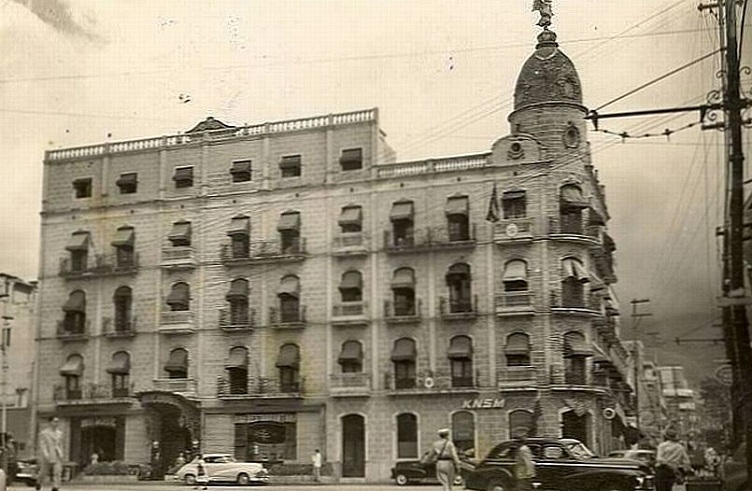
At that time, the Hotel Majestic (1930-1949), of European style, was an oasis for the high society of Caracas. Picture taken from the blog El Hotel Majestic: oasis de la Caracas de los 30′.
Therefore, the first diplomatic office of Japan in Venezuela opened its doors at the Hotel Majestic in the city of Caracas, on June 1, 1938. On August 19th, 1938, the Japanese Ambassador Kiyoshi Yamagata arrived at Maiquetía Airport, coming from Bogotá, where he had previously attended the inauguration of the new president of Colombia, Eduardo Santos (Yamagata was the Japanese Ambassador to both countries.) Yamagata formally presented his Credentials to the Venezuelan President Eleazar López Contreras on October 11th, 1938.
The First Japanese in Venezuela
The first Japanese immigrant to arrive in Venezuela was Mr. Seijiro Yazawa Iwai. He departed from Yokohama, and, after making a stop in Panama, he arrived in La Guaira in 1928. Mr. Seijiro Yazawa was born on October 26, 1901, his father was the president of Iwai Oil Manufacturing Company of Yokohama. But, when he was 23 years old, while he was studying at the Military College of Automobiles in Kawagoe, Saitama prefecture, he met the daughter of the Yazawa Commercial House. Despite opposition from his parents, he decided to marry her and inherit the business of the Yazawa family as an adopted son (Noguchi, 2008; see Note 1). Mr. Seijiro Yazawa died on April 2nd, 1988.
How did he learn about Venezuela and why did he decide to make a trip across the ocean? Well, it turns out, that one day, he invited his best clients to guide them through some sites in Niigata Prefecture. On that occasion, one of his clients mentioned that there was a lake in Venezuela called Maracaibo, where a well produced the same amount of oil that all the oil deposits in Japan (Noguchi, 2008; see Note 1).
To this story we add the following information: In 1928, Venezuela produced 106.5 million barrels of crude oil with only 85 active wells for an average of 1,252.9 thousand barrels per active well. Compare with Texas 1928 oil production of 255.4 million barrels with 910 active wells for an average of 280.7 thousand barrels per active well. On the other hand, total Japanese crude oil production from 1916 to 1922 averaged 2.48 million barrels (McBeth, B. S. (2002). Juan Vicente Gómez and the oil companies in Venezuela, 1908-1935 (Vol. 43). Cambridge University Press and Kobayashi, Giichiro (1925). Geology of the oilfields in Japan. Economic Geology, 67-82).
Thus, Seijiro Yazawa got interested and, therefore, did some research on Venezuela. Later, after receiving a letter of recommendation addressed to the Venezuelan Foreign Minister, he left Japan to come to Venezuela to search for oil fields. For almost a year he traveled the country and its oil fields. Then, he sent a report to the Ministry of Foreign Affairs of Japan requesting financial assistance from the Japanese government. But he got no support (Japanese Navy commanders felt that investing in a country beyond the Panama Canal was way too risky) (Noguchi, 2008; see Note 1).
After losing his hopes of acquiring oil concessions in Venezuela, Yazawa traveled to Panama in order to make a stopover there to return to Japan by ship. In Panama City, Japan had established its consulate in 1918, three years after the inauguration of the Canal. At that time, some 40 or 50 Japanese fishermen already lived there and another 40 were working as hairdressers. But, in 1931, when Yazawa arrived in Panama, there were already more than 300 Japanese.
A larger number of active Japanese fishermen began to have conflicts with Panamanian fishermen. On August 15, 1931, the Panama government prohibited fishing to the Japanese in seas close to the coast. Since the Japanese fishermen owned small boats, they could not sail into the open sea. But luckily, these struggling Japanese fishermen met Mr. Seijiro Yazawa who led them to the Caribbean shores of Venezuela (the Japanese Consulate in Panama informed their government that 18 people had moved to Venezuela in October 1931; they arrived with Mr. Yazawa in La Guaira on October 20, 1931 on board of a French steamship, where they also brought three small fishing boats) (Noguchi, 2008; see Note 1).
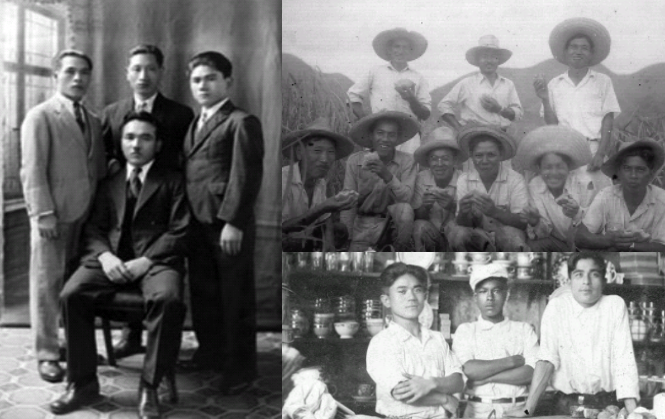
The first Japanese immigrants in Venezuela were fishermen who, after failing at fishing for a living, became farmers who cultivated the land. But, later, they also left agricultural activities to set up warehouses and stores in Caracas and other cities in the country. The photo on the left is from 1931.It shows the newcomers to Venezuela: Fukutaro Serizawa, Tatsuzo Sakakibara, Matsuo Horie and Sakae Watai. Photos taken from the book «La inmigración japonesa en Venezuela (1928-2008)»(see note 1).
However, it turned out that they could not make a living as fisherman in Venezuela. So, they stopped fishing and moved to Caracas where they became small farmers (they were able to rent a small piece of land and started to grow tomatoes, turnips, etc., whose seeds were provided by some Chinese neighbors who also worked in agriculture).
This is how the Japanese immigration started in Venezuela (Noguchi, 2008; see Note 1). However, months later, they also left farming activities to set up stores in Caracas and other cities in Venezuela. According to Guillermo Quintero (cited by Molina Medina, 2012, page 72, see note 1), by 1941, there were 52 Japanese in Venezuela; 30 men and 22 between women and children.
As to Seijiro Yazawa, after suffering many vicissitudes and experiencing lot of hard work (the full story is told in Molina Medina, 2012, pp. 46-49 and 254-259, Noguchi, 2008), in 1970, he founded the company Seijiro Yazawa Iwai C.A.(distributors, among others, of Toshiba medical products; today, this company has branches in Central America and the United States.)
In 1976, Mr. Seijiro Yazawa Iwai received from the Emperor Hirohito, the Order of Merit of the Rising Sun, and, in 1981, from the Venezuelan government, he received the Order Francisco de Miranda in its third class. Mr. Seijiro Yazawa also has the honor of being the first judoka on Venezuelan soil (in 1928, he was second dan).
(2) NIHON VES. Results of Our Preliminary Investigation
In this section we present the main research topics that will be addressed with our NIHON VES initiative.
(2.1) Japanese Scientists and Engineers Living in Venezuela
Our initial research has identified fifteen Japanese scientists and technologists teaching and working in research in Venezuela. However, if we take into account all Japanese engineers who have worked in the Venezuelan industries (mainly, in the steel, aluminum, automotive, oil and gas, and the generation of electrical energy industries), the Japanese scientists and technologists who have lived in Venezuela should add to several dozens. For the time being, the NIHON VES research line will attempt to study the life profiles of only five out of these fifteen identified Japanese professionals. Although a complete chronology of the arrival of Japanese scientists in Venezuela is not yet available, it seems that the first scientist to arrive in the country (in 1960) was the biophysicist and physiologist, Dr. Mitsuo Ogura (1928-2000).
(i) Japanese professors at Central University of Venezuela (UCV)
At UCV, up until today, we have identified six Japanese scientists. Four of them at the Faculty of Sciences of Central University of Venezuela (UCV). In the sixties, the Faculty of Science, which had been created in 1958, was like a small United Nations session. Along with a handful of Venezuelan scientists, there were professors of many nationalities including three Japanese nationals: Mitsuo Ogura (1928-2000), Yoshikatsu Yoshida and Masahisa Hasegawa (1938-2012, who joined the School of Chemistry, Faculty of Sciences, in 1968). Makie Kodaira Sugawara (b. 1947), the forth Japanese scientist at this institution joined the faculty in 1977.
The case of food scientist Makie Kodaira Sugawara is different from the other scientists. In the first place, she is the only woman in the group of Japanese scientists in Venezuela and, secondly, because she received her education in Venezuela and in Japan. Although, at this time, our NIHON VES research line has not included her name among the cases to be investigated, it is worthwhile to briefly review her academic career. The Japanese-Venezuelan Makie Kodaira was born, in 1947, in Nagano (長野 市), the capital city of Nagano Prefecture in the Chūbu region (the central region of the island of Honshu). She came to Venezuela when she was very young. For her high school studies she attended Liceo “José Antonio Paéz” (graduating in 1969). She later enrolled at Andrés Bello Catholic University where she majored in Education, with an specialization in Biological Sciences (in 1973, she earned the degree of Licenciado en Education). Then, she traveled to Japan to do a Master’s degree in Agriculture at the University of Hiroshima (1977). Upon her return from Japan, Makie Kodaira joined the Faculty of Sciences’ Institute of Food Science and Technology where for twelve years she served as the Chief of the Fishery Products Section. In her professional career, Makie Kodaira reached the title of Full Professor (2001) and, in 2002, she retired. Professor Kodaira is regarded as an expert in Fishery Products Technology.
The other two Japanese scientists at UCV were: Tatsuhiko Nakano (1925-2004), at the Faculty of Pharmacy; and Kozo Ishizaki (b. 1946), at the Faculty of Engineering. However, in reality, we only have five Japanese scientists at UCV since the chemist, Tatsuhiko Nakano was mainly associated with the Venezuelan Institute of Scientific Investigations (IVIC) and only taught some courses at the Faculty of Pharmacy. In NIHON VES, we will center our attention on the lives of Mitsuo Ogura, Yoshikatsu Yoshida and Kozo Ishizaki. The case of natural product chemist, Masahisa Hasegawa will not be studied by the NIHON VES research line. However, when we review the cases of collaboration between Japanese and Venezuelan laboratories we will briefly comment on his professional career.
Biophysicist OGURA, Mitsuo (1928-2000) (name in Japanese, 小倉, 光夫)
Prof. Mitsuo Ogura, doctor of Medicine from the University of Kyoto. His doctoral thesis was carried out on the application of electronic microscopy in the biological area, in the Department of Bioelectronics of the University of Kyoto (Finol, 2010, p. 55; see Note 2). He arrived in Venezuela in 1960. We do not yet know the exact landing date, but we have records of his being hired by the Department of Biochemistry and Biophysics of the School of Biology of the Faculty of Sciences, on September 15th, 1960, to start studies of animal physiology. He was born in 1928. We could not find out his exact birth date and where he was born, but we suppose it was in the Kansai region near Kyoto Prefecture or in the city of Kyoto itself. In Japan, Dr. Ogura worked for the universities of Kyoto (School of Physiology of the Faculty of Medicine 京都 大学 医学 部 生理学 教室) and as Assistant Professor in the Department of Physiology of the Faculty of Medicine at the University of Mie (三重 大学). At this stage in our research, we know very little about his educational formative process in Japan and his family data.
Dr. Ogura had a great influence on the institutionalization and development of electronic microscopy in Venezuela (on June 6, 2003, the Electronic Microscopy Center of the Faculty of Sciences, UCV was named The Mitsuo Ogura Electronic Microscopy Center). Professor Ogura also created the Biophysics Group at the Institute of Experimental Biology (IBE) of the Faculty of Sciences which later evolved into what is now called the Biophysics Laboratory of the Cell Biology Center of the IBE.
Mitsuo Ogura also had an active participation in the Japanese community in Venezuela. He was the third president (1979-1980) of the Japanese Association of Caracas (First period) and the fifth president (1984-1984) of the Nikkei Federation of Venezuela (formerly the Japanese Association of Venezuela). Much remains to be investigated about the life of Professor Ogura in Japan and in Venezuela. We do not know the exact date of his death, we only know that it happened in year 2000.
Mathematics Professor YOSHIDA, Yoshikatsu
Our preliminary inquiries have unearthed few facts about Yoshikatsu Yoshida. Until now, with the data we have already gathered, the following story can be told:
We know with certainty that, in 1963, Yoshikatsu Yoshida was a hired professor of Mathematics at the School of Physics and Mathematics, UCV to teach several math courses. The hard data we have is a 1963 Mathematics Program (UCV) where Prof. Yoshida is mentioned as the instructor for the courses Analysis IV (4th semester subject) and Functional Analysis (8th semester). It seems, however, that his training (possibly at the University of Tokyo) was not in mathematics but in theoretical physics. This is an inference taken from a story that comes to us from Colombia.
It happens that the then Rector (President) of the National University (UNAL) of Colombia, Mario Laserna (1948-2013) promoted a cultural exchange with Japan. As a result of a binational cultural agreements, four Japanese professionals traveled to Colombia on an official two-year mission to teach mathematics and, upon completing their mission, they were to return to Japan. These teachers were: Yu Takeuchi (1927-2014), Yosikazu Eda, Soichi Hosoi and Yoshikatsu Yoshida. This information was told by Yu Takeuchi in an interview with Clara Helena Sánchez (Sánchez, 2009; see Note 3). This official Japanese mission arrived in Colombia on December 15, 1959. Yu Takeuchi was born, in Tokyo, on March 16, 1927. In 1948, he graduated in theoretical physics from the University of Tokyo. He had studied physics under pressure from his father, who was a physicist, but his vocation was in Mathematics.

Yu Takeuchi’s university identification card as professor at the Faculty of Sciences, National University of Colombia (1959). Credit: Yu Takeuchi Fund, Historical and central archive of the National University, Bogota Headquarters.
De estos cuatro profesores dos no se regresaron al Japón. Yu Takeuchi, al final de la comisión, la extendió por un año más, y, finalmente, después de su tercer año, decidió quedarse en Bogotá enseñando matemáticas en la UNAL llegando a tener una gran influencia en la institucionalización de las matemáticas en Colombia (hoy en día
Of these four teachers, two did not return to Japan. Yu Takeuchi, at the end of the commission, extended his stay for another year, and finally, after his third year, he decided to remain in Bogota teaching mathematics at UNAL. He had a great influence on the institutionalization of mathematics in Colombia (today, the building of the UNAL’s Department of Mathematics, Physics and Statistics is named Yu Takeuchi). And the other Japanese who did not returned was Yoshikatsu Yoshida. In Colombia, Yoshikatsu Yoshida taught Topology lessons; from the interview with Takeuchi it can be inferred that Yoshida was also a physicist and probably also a graduate of the University of Tokyo and perhaps from the same cohort as Takeuchi.
Yu Takeuchi: “I was working in physics at the University of Ibaraki, about 100 km north of Tokyo…. Un compañero (a colleague), Yoshikatsu Yoshida, came with me. He was a physics teacher, the father of Mari Yoshida [who studied physics at UNAL and, later, joined the faculty of UNAL’s Physics Department and is currently retired], he wanted to teach topology. He taught it without knowing Spanish and it was very difficult”. However, when Takeushi refers to Yoshida as a “compañero”, it may be not because Yoshida was his classmate at the University of Tokyo but, maybe, Yoshida was his co-worker at Ibaraki University. But, we do not know.
Presumably, when the two-years contract with the Japanese government ended, Prof. Yoshida came to Venezuela. But, we do not know if he also extended his contract for another year or if, at the end of his official commission, he came to Venezuela. He could have arrived in Venezuela in 1961-1962, but, at the moment, we only have proof of his being in the country in 1963. That’s all. We have no more information about Prof. Yoshida.
Materials scientist ISHIZAKI, Kozo (name in Japanese, 石崎, 幸三)
Now, we turn our attention to the Japanese material scientist Prof. Kozo Ishizaki, a metallurgical engineer and professor of materials science, first at UCV (Assistant Professor, 1974-1976), for a short time (1980-1981), he worked as the Head of Materials at the Venezuelan Institute of Technology for Petroleum (Intevep), and, for most of his career in Venezuela, he was affiliated with Simón Bolívar University (USB) (where he was Associate Professor, 1976-1984; head of Laboratory E (1983-1985), Full Professor, 1984-1985, and Honorary Professor, 1994). The impact of Professor Ishizaki on the USB seems great, which is reflected in the fact that he received the appointment of Honorary Professor. In 1985, Prof. Ishizaki returned to Japan and became part of Nagaoka University of Technology where, later, he became vice-president of the university (2003-2007).

Prof. Kozo Ishizaki. Photo credit: Documentation and Archive Center (Centro de Documentación y Archivo), USB.
Kozo Ishizaki was born, on September 26, 1946, in Takamatsu, Kagawa. His parents were Takeo and Ai (Kubo) Ishizaki. He studied engineering at the Tokyo Institute of Technology (Bachelor in Engineering, 1969) and then did his doctorate at the University of Maryland, USA (Ph. D., 1974) and, after finishing his doctorate degree, he came to Venezuela to teach at the School of Metallurgical Engineering and Materials Science, Faculty of Engineering, UCV.
(ii) Japanese scientists working in Eastern Venezuela
A group of five Japanese scientists worked in Eastern Venezuela all associated with marine sciences: oceanography, marine chemistry and fishery. They were affiliated with several public and private scientific institutions: the Margarita Marine Research Station (EDIMAR by its Spanish acronym), a La Salle Foundation institute (Jiro Fukuoka); the Fishery Research Center, in Cumaná, Sucre State (Takeshi Nemoto), this center was an entity attached to the, then, Ministry of Agriculture of Venezuela (Ministerio de Agricultura y Cría, MAC); and the Oceanographic Institute of Venezuela (IOV) of the Universidad de Oriente (Jiro Fukuoka, Kenji Kato, Taizo Okuda, and K. Nagata).
Oceanographer OKUDA, Taizo (name in Japanese, 奥 田, 泰 造) became the director of the IOV and spent the major part of his career (more than 20 years) at this institution. Like KATO, Kenji (name in Japanese, 加藤, 健 司), in Japan, during the early fifties of the 20th century, Taizo Okuda was affiliated with the Faculty of Fisheries at Hokkaido University. However, in NIHON VES, we will only study the case of the physical oceanographer, Jiro Fukuoka (1922-2004), see below.
Physical Oceanographer FUKUOKA, Jiro (name in Japanese 福岡, 二郎)(1922-2004)
Our preliminary investigations seem to indicate that before coming to Venezuela, Jiro Fukuoka worked for the Meteorological Research Institute in Tokyo. In Venezuela, he worked (we know about his presence in the country since 1962), first for EDIMAR and, later, for the IOV. On his return to Japan, he joined the University of Hokkaido (where Kenji Kato also worked), specifically, with the Research Institute of North Pacific Fisheries, Faculty of Fisheries, Hokkaido University.
Using our Digital Historical Survey methodology, we were able to find a scanned copy of his obituary in Japanese, so we now know that he died on December 24, 2004, at age 82. We now have to get his obituary translated and collect and study his scientific work. Unfortunately, the photo in the obituary is of poor quality. But we will try to find the original journal page where this obituary was scanned from.

Shortly before his death, Dr. Tamotsu Imaeda received the Andrés Bello Order from the Venezuelan government. Photo taken from the New Jersey Medical School website.
(iii) Japanese Scientists at IVIC
Three other Japanese researchers worked for the Venezuelan Institute of Scientific Investigations (IVIC): the neurophysiologist Koroku Negishi; the dermatologist and expert in the microbiology of leprosy Tamotsu Imaeda (name in Japanese 今枝保; 1927-1988) who worked at IVIC for approximately 10 years (1959-1969) and then moved to the New Jersey Medical School (1969-1988); the natural product chemist Tatsuhiko Nakano (Osaka, 1925- Kyoto, 2004); and the microbiologist Fuminori Kanetsuna. For the time being, the NIHON VES initiative will not study the lives of these interesting Japanese scientists.
(iv) The Japanese telecommunications expert SHIMIZU, Naoshi at the CETT of CANTV
Finally, the fifth Japanese national to study in NIHON VES is Naoshi Shimizu, a Japanese expert in radio communications working for the International Telecommunication Union (ITU). He was in charge of the training of Venezuelan technicians in telephony at CETT (Centro de Entrenamiento de Técnicos de Telecomunicación; in English, Training Center for Telecommunications Technicians) of the CANTV telephone company.
In 1962, the Venezuelan government asked the United Nations Special Fund for assistance in the creation of the CETT. In 1964, an agreement was signed by the Venezuelan Ministry of Communications, the ITU Assistant Secretary-General and representatives of the United Nations Development Program (UNDP).Then, CETT activities began with the training of 400 technicians to do maintenance on the installed telephony equipment base.
(2.2) Venezuelan Technology in Japan: Orimulsion® and the Contribution of the Japanese
Orimulsion was a novel liquid fuel with a complex business chain, which included the production of natural bitumen, emulsification of the bitumen (i.e. the manufacture of Orimulsion), transporting the product to distant countries and the combustion (or burning) of Orimulsion in the boilers of electric power plants. Orimulsion, mainly, competed with coal as fuel for power generation plants. I write in the past tense because, as we know, the new style of government in Venezuela decided to stop the production of Orimulsion. Orimulsion was perhaps the only high-tech product that Venezuela has exported to Japan (from 1988 to approximately 2007).

Tank for the storage of the Orimulsion inthe Production and Emulsification Plant in Morichal, Monagas state. Photo taken from the Annual Report of Bitor, 1995.
Indeed, in May 1988, even when the subsidiary of Petróleos de Venezuela (PDVSA), Bitúmenes del Orinoco, SA (Bitor), the company that would eventually be responsible for producing and emulsifying the natural bitumen and commercializing the Orimulsion in the world, had not yet been created, a cargo shipment of 31,000 barrels of Orimulsion from Venezuela went out for the first customer to try this product in the world: Chubu Electric Company in Nagoya, Japan. The company Bitor was created in October 1988.
For Orimulsion to be accepted in international markets, the problem of filtering or eliminating the pollutants generated by the combustion of Orimulsion (nitrogen oxides, sulfur oxides and ash derived from combustion) also had to be solved. In other words, Orimulsion had to be made a clean, non-polluting fuel. Especially, emulsification and combustion represented a technological problem for Bitor (and for PDVSA research institute Intevep)
For the commercialization of Orimulsion in Japan, Bitor made an alliance with Mitsubishi Corporation and formed a new company called Mitsubishi Corporation-Bitor Limited (MC Bitor). In NIHON VES we want to explore what might have been the Japanese contributions to solve some of these technological problems.
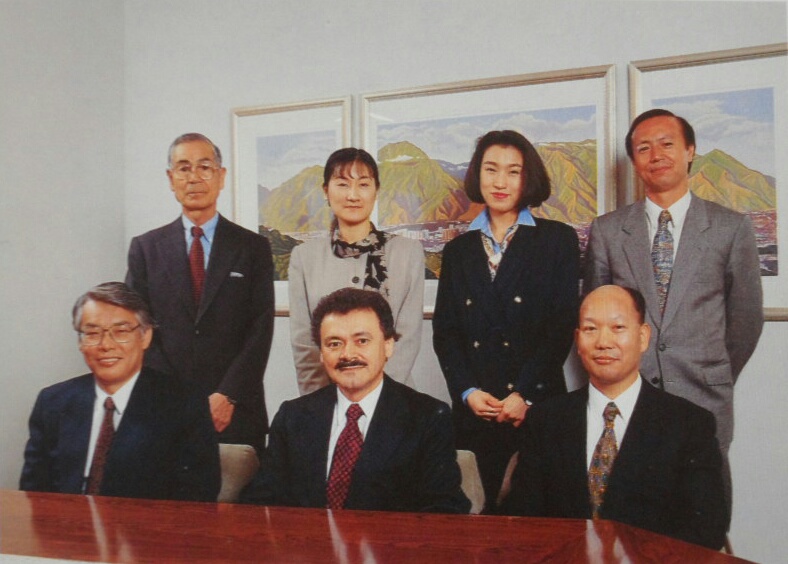
MC Bitor visiting in Caracas. From left to right: Toshio Ogawa, Emi Saeki, Mio Ishihara, Takatoshi Osawa. Seated: Masayaki Arakawa, Raúl Alemán and Yasuo Nakane. Photo taken from the Annual Report of Bitor, 1995.
For 1995, MC Bitor’s customers in Japan were Kashima Kita Electric Power Corporation, Mitsubishi Chemical Corporation and Kansai Electric Power Company Incorporated (among the three they received 850 thousand tons of Orimulsion and it was expected that by the end of 1996 the company Hokkaido Electric Power Plant would be added as a new client ( with 120 thousand tons of Orimulsion). In 1995, the production of natural bitumen (to make Orimulsion) was 2 million 825 thousand tons, while the total production of Orimulsion was 3 million 685 tons. As we can see, in 1995, the Japanese market represented 23% of Orimulsion’s production. In 1996, MC Bitor supplied 925 thousand tons to the Japanese market (8.8% more than in 1995): this was due to the fact that a boiler came into operation at the Hokkaido plant specially designed to burn Orimulsion.
Here, we can not tell the story of the development of a cutting-edge technology such as Orimulsion, therefore only a brief summary will be given. Technically, it is said that Orimulsion is an emulsion that
(…) consists of basically 70 per cent natural bitumen of 7-10 API gravity, 30 per cent water and a commercially available surfactant, nonylphenol ethoxylate, which is added to stabilise the emulsion and prevent the water and bitumen from separating. However, the process is not as elementary as it sounds because one of the key factors enabling ORIMULSION®; to achieve its high combustion efficiency rate of 99.9 per cent is the small size of the bitumen droplets in the emulsion. Each need to be about 20 microns or one-fiftieth of a millimetre in diameter and evenly distributed in the water (Hebe Vessuri y Maria Victoria Canino, en Sociocultural Dimensions of Technological Learning), Science, Technology and Society, 1996. vol. 1, No. 2, Sage, Nueva Delhi).
Orimulsion is a Venezuelan innovation that was, mainly, developed at the Venezuelan Institute for Technology for Petroleum, better known by its acronym Intevep, S.A. (today, PDVSA Intevep) (in collaboration with the company Lagoven) in a period of approximately seven to eight years. But it has its origins in the main result of of a three-year research agreement between Intevep and BP Research International which was carried out in 1981: a technology called Imulsion® (the resulting patent is jointly owned by BP and Intevep).
In the early eighties, the main problem was not producing a liquid fuel to compete with natural coal. The difficulty and objective were others: how to make the natural bitumen, which is a super viscous crude, to flow easily through oil pipelines. In 1985, independently, and to their great surprise, Intevep and BP discovered that emulsified bitumens not only flowed easily through the pipelines but also burned very well in the boilers. At Intevep there were two research groups: the Emulsion Group (Ignacio Layrisse, Hercilio Rivas and María Luisa Chirinos, among others) concerned only about the transport of the bitumen through pipelines and the Bitumen Combustion Group (led by chemical engineer Domingo Rodríguez Polanco (BSc in Chemical Engineering from UCV, 1970, and PhD in Combustion Engineering, from Imperial College, London, 1975).
In view of the business potential of creating a new fuel, these two groups joined forces and, with the Imulsion® technology, created a new emulsion for which Domingo Rodríguez coined the name: Orimulsion. Now, in order to produce Orimulsion commercially, the problem of scaling had to be solved. That is, how to produce Orimulsion industrially after its initial formulation in the research laboratory; essentially a practical (mixing) problem of non-Newtonian fluid dynamics.
In 1986, upon his return to Venezuela after having earned a PhD in Fluid Mechanics at the University of Minnesota, Gustavo Núñez Testa (1958-2013)joined Intevep. At this institution he developed a large part of his successful professional career as an applied scientist, business manager of Orimulsion (1986-1999) and, later, as planning manager of Intevep (1995-1997).
Now, we know that Gustavo Núñez traveled extensively to Japan and developed excellent relationships with Japanese engineers and entrepreneurs from companies such as Tokushu Kika Kogyo (TKK) (in particular, with Akira Furuichi). With TKK Intevep signed an agreement to use TKK mixing technologies. But, in the end, none of the Japanese mixing machines solved the Orimulsion mixing problem. However, Intevep engineers finally developed their own technology: a mixer they named Orimixer®. Now, this new mixer could not have been made without the learning process achieved through the agreement with TKK to understand the Japanese mixing technology. How those relationships developed is an aspect that we would like to study with our NIHON VES initiative.
The other topic about which we know very little today is the Japanese contributions to make Orimulsion a cleaner fuel. We know that Kansai Electric Power Company, in December 1995, completed a study on the environmental impact of Orimulsion and that all MC Bitor Japanese customers did Orimulsion combustion tests and these tryout tests were essential for the sale of Orimulsion in the Japanese market. This is also a hidden story that we also want to investigate and write about.

(2.3) Collaboration Between Venezuelan and Japanese Research Laboratories
Another subject that we wish to explore with NIHON VES is the scientific collaboration between research laboratories in Venezuela and Japan. So far we have discovered few collaborations worth mentioning. Although, for the moment, at NIHON VES, we only study those collaborations in the physical and material sciences.
(i) Between IVIC and the University of Kyoto
The first collaboration worth mentioning is related to a joint work between IVIC and the University of Kyoto. It turns out that, in 1960, Tatsuhiko Nakano (who earned his PhD at the University of Kyoto, in 1955, and, between 1956 and 1960, was postdoctoral fellow at American universities, including Stanford University) joined the Faculty of Pharmacy at the University of Kyoto as an Associate Professor and Masahisa Hasegawa (1938-2012) was his doctoral student. By 1964 they had two scientific publications together.
But, in 1965, Dr. Nakano emigrated to Venezuela and Hasegawa finished his doctoral thesis work in the laboratory of Dr. Nakano at IVIC in Venezuels. And, after obtaining his PhD degree from the University of Kyoto, Hasegawa returned to Venezuela and, in 1968, he joined the School of Chemistry of the Faculty of Sciences (UCV) where, for more than 35 years, he worked as an active professor, teaching Chemistry Organic and researching in Phytochemistry.
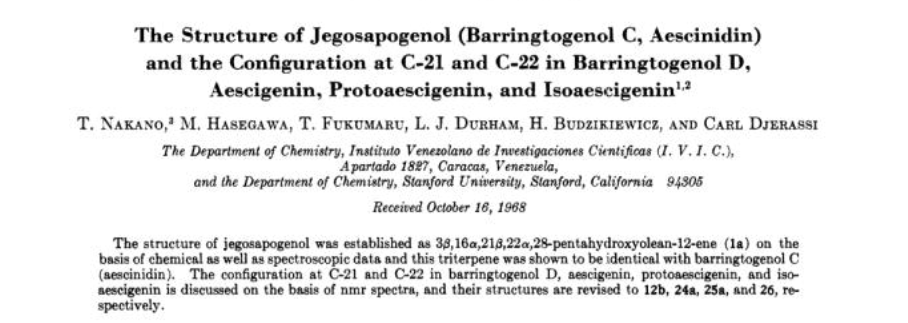
Work of Nakano and Hasegawa at IVIC. This publication was part of Hasegawa doctoral thesis at the University of Kyoto (1968).
(ii) Collaboration in the Medical Sciences
There are also collaborations in medicine: (1) in the study of Leishmaniasis: a work between Iraida Mendoza Nieto of the Health Dermatology Service, Immunology Building, Central Hospital, State of Lara and several parasitology laboratories of Japanese universities (Hokkaido University, The Japanese Red Cross College of Nursing, in Tokyo, and Kochi Medical School, Kochi University), (2) early detection of gastric cancer; studies conducted between the Tachira State Cancer Control Center and Japanese entities, and (3) in tropical dermatology: work of the National Institute of Dermatology and Japanese scientists.

Work of Venezuela National Institute of Dermatology scientists in collaboration with Japanese colleagues.
(iii) Research in Food Sciences
Another collaboration we found is related to a nine-month research internship (1-10-1999 to 06-30-2000) conducted by Professor Makie Kodaira of the Fishery Products Section of the Institute of Food Science and Technology (UCV) in “Chemical estimates of fish freshness and its application” in the Laboratory of Utilization of Marine Bio-Resources, at the Faculty of Applied Biological Science, Hiroshima University.
(iv) Collaborations in Materials Science
Prof. Joaquín Lira-Olivares is another of the researchers we want to mention in relation to the collaboration between research laboratories of Venezuela and Japan. Today, he is Professor Emeritus at Universidad Simón Bolívar (USB). He can be considered as a “Berkeley-man” as he completed all his university education at the University of California, Berkeley (UC, Berkeley).
On January 27, 2017, when he turned 80 years old, there was an event in his honor where his name was given to a Conference Room located in the Mechanical and Materials Building (MEM) of the USB campus, in Sartenejas. In this event, Prof. Lira-Olivares said that “We [meaning the academic community] are here to create and teach. Creativity is the only response to the crisis ” and suggested that mechanisms must be considered and relationships established to work together with universities in other countries. The Department that he help to found has, for a long time, pursued collaborations with German and Spanish universities, and, of course, years later with Japanese universities.
In that same event he also recalled the first international collaboration in Materials Science at USB: “I joined the USB as a professor of the Department of Physics and head of the Metallurgical Research Institute, as there was contact with the industry. The Coal research group was created with professors from France and the United States, who laid the foundations for the formation [,in 1975,] of the Department [of Materials Science].”
Prof. Lira-Olivares obtained from UC, Berkeley the following degrees: Bachelor of Arts in Physics, 1963; Master (MA), Education Sciences (1965); Master (MSc) in Metallurgical Engineering, ( 1970); and the Doctorate (Ph.D) in Sciences of Engineering (1974). In 2001, the Nagaoka University of Technology awarded him the Honorary Doctorate (H.D.). In 2004, he received the Medal and Diploma Order of the Rising Sun from Japan (Gold with Neck Ribbon).
Dr. Lira-Olivares is a material scientist interested in the study of ceramic materials (especially the glaze of ceramics), tribology, biomaterials and eco-materials (ecological materials). One of his USB masters students, Gustavo Alberto Rosales-Sosa, made a great scientific discovery in his doctoral work at the Department of Materials Engineering, University of Tokyo (see below in the section entitled “Venezuelans doing science and technology in Japan.”
Undoubtedly, the works of Prof. Lira-Olivares, who is the director of the Center for Surface Engineering (CIS), at USB, where he conducts research in the areas mentioned above, and his relations with Japanese universities and institutions (Nagaoka University of Technology, University of Tokyo, The Institute of Scientific and Industrial Research of the University of Osaka), is a subject that should be studied by the NIHON VES initiative.
(v) Research in Low Temperature Physics: Superconductivity
Finally, we also found that there have been several collaborations between IVIC’s Low Temperature Laboratory, led by Dr. Ismardo Bonalde, and several Japanese universities. In particular, Dr. Bonalde has had a close collaboration with several Japanese scientists in the study of superconductivity: Prof. Noriaki Kimura (Tohoku University), Prof. Yoshichika Onuki, (Osaka University), Prof. Rikio Settai (Niigata University), and Prof. Fuminori Honda (Institute for Materials Research, Tohoku University, Ibaraki).
(2.4) Venezuelans Doing Scientific and Technological Research in Japan
Because Venezuela is an undeveloped country, one might think that the contributions in techno-scientific areas have only been coming from one side: from Japan to Venezuela. Although, as we have seen with the case of the exporting of Orimulsion® to Japan, we can realize that this is not quite true. But there is another more interesting and exciting fact, about which we, presently, know partial details of only a few cases (of maybe hundreds). We are talking about another dimension of the hidden garden: the Venezuelans doing ( or about those who have done) science and technology in Japan. We suggested that, perhaps, there are hundreds of cases because “by the end of 2006, Japan had been financing the presence of 715 Venezuelan scholars” in Japan (Molina Medina, 2012, p.130, see note 1).
The case of David Lanza
Let us first review one example. Nine years ago, David Miguel Lanza Medina was a young student at the Simón Bolívar University (USB) aspiring to a degree in Mechanical Engineer. The title of his thesis reads: “Design, study and construction of a ring speedometer to be used in an energy self-generation instrument for the monitoring of fluvial channels.”
The first lines of the summary of his thesis clarify the purpose of his research work: “Due to the incalculable natural disasters and human losses as well as materials caused by the overflow of rivers in Japan, it is necessary to develop an efficient, economic and reliable instrument capable of monitoring and predicting the behavior of rivers. The purpose of this research is to develop a speedometer based on the phenomenon of Karman Vortices using an annular geometry as the generator of the vortices. This device is called a ring speedometer and will be used in an energy self-generation instrument that is being developed at the Nagaoka University of Technology for the monitoring of fluvial flows.”
Funded by Teikoku Oil of Venezuela, and, we suppose, because his thesis does not indicate it, under the agreement that exists between the Nagaoka University of Technology and the USB, David Lanza carried out a one-year research internship (2006-2007 ) at this Japanese university. Advised by professors TAKAHASHI, Tsutomu and SHIRAKASHI, Masataka, David Lanza carried out his research work which he later used to defend in Venezuela, at USB, in June 2008, a thesis dissertation with the title that has already been mentioned. David Lanza graduated in 2008 and, today, works for the Venezuela office of Mitsubishi Corporation.
How many contributions of Venezuelans to science and technology in Japan remain unknown or hidden? Note that this example does not fall into the category of the “715 Venezuelan fellows” of the Japanese government scholarships as his stay in Japan was paid by a private Japanese oil company. Here, before mentioning other cases, it is worth noting that the agreement between the Nagaoka University of Technology and USB has sent dozens of Venezuelan students to Japan and we must not forget that for several years the Vice President of the Nagaoka University of Technology was Prof. Kozo Ishizaki, USB Honorary Professor. The relevance of the Kozo Ishizaki connection is an issue that deserves study. But, let’s keep going.
Study Cases: María Leonor Pacheco, Pedro Celis y Manuel Brito Salazar
Many other students, in one form or another, have benefited from this relationship with the Nagaoka University of Technology. Consider the cases of María Leonor Pacheco, Pedro Celis and Manuel Brito Salazar.
María Leonor Pacheco
Today, she is a PhD student in Computer Science at Purdue University. In 2013, she graduated in Computer Engineering from the Universidad Simón Bolívar (USB). Between 15-09-2011 and 30-07-2012, she did an internship as a visiting research student at the Nagaoka University of Technology in the Knowledge Systems Laboratory of Professor YUKAWA, Takashi where she carried out a research project to extract information from tweets during major emergencies for disaster relief. Her stay in Japan was financed by JASSO (Japan Student Services Organization), an administrative unit of the Ministry of Education, Culture, Sports, Science and Technology of Japan (Monbukagakushō,) through a grant called in Japanese 文部科学省奨学金 (Monbukagakushō Shōgakukin.)
Pedro Celis
In 1984, when Professor Kozo Ishizaki was still working at USB, Pedro Celis earned his bachelor degree in Materials Engineering with a thesis on fatigue in a special class of steel class called nitrided steels, and then, in 1986, he received a Japanese government scholarship (called Monbusho, this is the old name of the Monbukagakushō Shōgakukin scholarships), and, while studying Japanese to enter graduate school, he spent a year as a research student at Nagaoka University of Technology, doing research in the field of ceramic materials.
Later, at the same university, under the advice of Prof. Kozo Ishizaki, he completed a master’s and a doctorate in Materials Science. Pedro Celis has six research papers published together with Kozo Ishizaki and other Japanese authors in the field of manufacturing processes of new materials (ceramics and metals). In 1992, the Nagaoka University of Technology awarded Pedro Celis a PhD in Materials Engineering (the title of his doctoral thesis is “Design and Production of Light Intermetallics of High Fusion Point of the Type (Si3Zr5) 16H”).
The case of Professor Manuel Brito Salazar
Today, and since 2013, Manuel E. Brito (Manuel Eduardo Brito Salazar) is a professor at Yamanashi University, in Kofu, Yamanashi Prefecture, southwest of Tokyo, and is affiliated with the Clean Energy Research Center (Center Research in Clean Energies) of that university. This is the case of a Venezuelan scientist who has developed his entire professional career in Japan.
In 1982, Manuel Brito received a Materials Engineer degree from USB. Subsequently, he traveled to Japan where he completed his MA (1986) and PhD (1989) in Materials Science at the Nagaoka University of Technology, Between 1989 and 1990 he was Assistant Professor at the Nagaoka University of Technology. Between 1990 and 1992, he completed a post-doctorate at the National Institute for Inorganic Materials (NIRIM), of the Science and Technology Agency (Japan). Then, he became Chief Senior Research Scientist, at the National Institute of Advanced Industrial Science and Technology (AIST) (2000-2013) and Senior Research Scientist, National Industrial Research Institute of Nagoya (NIRIN), Agency of Industrial Science and Technology (1992- 2000).
Professor Brito’s research interests are related to the microstructural analysis of materials using electronic microscopy (TEM, STEM, EDS, and EELS), the study of interfaces between dissimilar materials, grain edge engineering (GBE, Grain Boundary Engineering), diffusion phenomena in solid state materials and the study of fuel cells (solid oxide fuel cell (SOFC) with Raman spectroscopy, XPS (X-ray photoelectron spectroscopy) and SPM (Scanning Probe Microscopy).
Gustavo Alberto Rosales-Sosa
Another example of a Venezuelan scientist who is giving headlines in Japan is a former student of Joaquín Lira-Olivares about whom we have already talked about. We are referring to Dr. Gustavo Alberto Rosales-Sosa. In 2007, Gustavo Rosales, who was then a student in Materials Engineering laboratory of Prof. Joaquín Lira-Olivares (that is to say, at USB’s Center of Surface Engineering (CIS)), defended his thesis dissertation (entitled, “Development of frits and glass-ceramic glazes with a high content of Fe2O3”) carried out under the advice of another of the CIS professors, Dr. Thierry Poirier. This thesis work of Gustavo Rosales was part of a five-year agreement (2007-2012) between USB and the Universitát Jaume I, in Castellón de la Plana, Valencia, Spain for the “Development of glass-ceramic frits and enamels for electrical and magnetic applications.”
After completing his undergraduate degree, Gustavo Rosales continued working on research topics associated with this agreement. In 2012, he earned from USB a master’s degree in Materials Engineering tutored by Thierry Poirier and Joaquín Lira-Olivares (Thesis: “Effect of additive oxides on frits” and glass-ceramic glazes in the Fe-Al-Ca-Si system”.) But, in the interim, during 2011, Gustavo Rosales got support from JASSO to attend as an research exchange student at the Nagaoka University of Technology, and, subsequently, he received a Monbukagakushō scholarship, and with this support he traveled to Japan to work for a doctorate degree in Glass Science at the Department of Materials Engineering of the University of Tokyo.
The aim of his doctoral thesis project was to try to understand the relationships between the structure and the mechanical property of new kinds of glasses manufactured without using the conventional way of doing them by means of aerodynamic levitation.
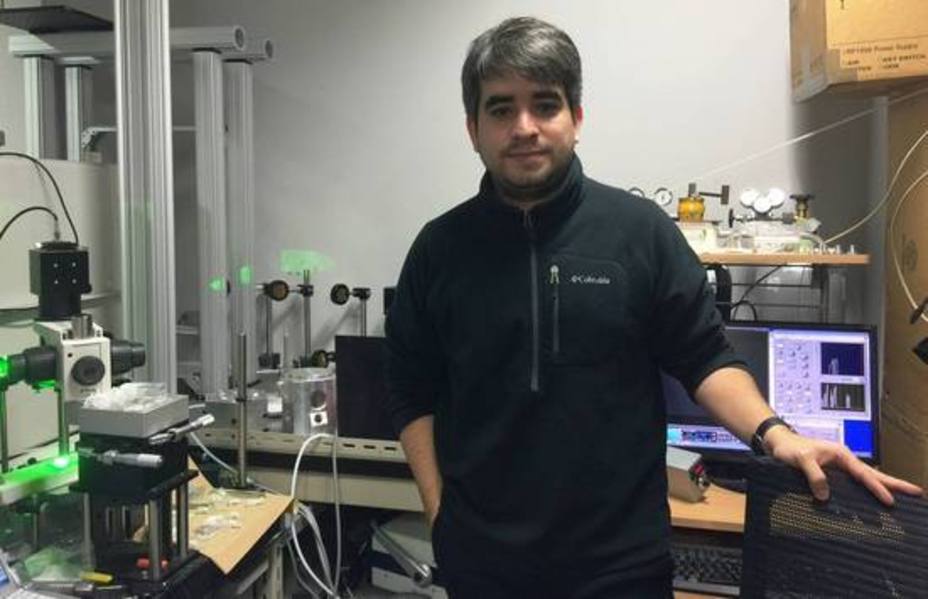
Gustavo Rosales working in the laboratory at the University of Tokyo. Photo credits: USB news portal.
It is within the framework of this project that, as a member of the research team of the Institute of Industrial Sciences (IIS) of the University of Tokyo, he made the great discovery of super strong or “ultra-hard” glasses.
These are a new type of glasses, as rigid as steel and iron, but they are clear and transparent. The new glass produced was obtained by using aluminum oxide and tantalum oxide in the mixture under a technique (aerodynamic levitation) that uses gas to prevent instantaneous crystallization of the mixture. Scientific Reports magazine published the works associated with this discovery: “High Elastic Moduli of a 54Al2O3- 46Ta2O5 Glass Fabricated via Containerless Processing” and “Crack-resistant Al2O3-SiO2 glasses”. Since January 2017, Gustavo Rosale-Sosa is working as a researcher for the company Nippon Electric Glass, in Shiga, Japan.
Two other examples of Venezuelans who have contributed to science and technology in Japan are Gustavo Rosales’ wife, Denise Zujur, and although he lives in Switzerland today, we can also mention the name of Octavio Kotaro Ichizaki (son of Prof. Kozo Ichizaki with his wife Chanel Vidal; Dr. Chanel Ishizaki worked in the Environmental Engineering Laboratory of IVIC in environmental pollution problems and has a Ph.D. in Civil Engineering (1973) from the University of Maryland, College Park, which she earned with the thesis: “Surface chemistry of activated carbon: its influence on adsorption from aqueous solution”, directed by Prof. John T. Cookson). We also have news of other Venezuelans working in research and development for Toshiba and other Japanese companies.
Denise Zujur
Denise Carolina Zujur earned from USB her bachelor’s degree (Thesis, 2009: Study of the degree of deterioration by corrosion of electrolytic cleaning tanks I and II of SIDOR) and master’s degree (with a thesis in biomimicry, 2013, entitled: Evaluation of bone biomimetic coatings based on photosensitive chitosan on TI6AL4V) both in Materials Engineering. Currently, she is pursuing a PhD degree in Bioengineering at the University of Tokyo. Recently, the journal Science published one of her research work which is related to tissue engineering and regeneration of bone tissue using stem cells.
Octavio Kotaro Ishizaki
On the other hand, Octavio Kotaro Ichizaki was born in Caracas in 1977. He spent a few of his early years in Venezuela, but he finished his primary school in Japan and continued his secondary education in that country. Like his father, Octavio Kotaro studied materials science:at Chiba Institute of Technology (undergraduate in Metallurgical Engineering, 2001); Master of Science in Materials (2003) at the Japan Advanced Institute of Science and Technology, Ishikawa (School of Materials Science); and, in 2006, he earned his Ph.D. in Engineering from the Tokyo Institute of Technology (Department of Chemistry and Materials Sciences) with a thesis related to the production of iron through microwave heating. Since 2007, Octavio Ishizaki has been working in sinterization of materials by microwave heating for the Swiss Federal Laboratories for Material Science and Technology (sinterization is the thermal treatment of metallic or ceramic powders at a temperature below the melting temperature of the powder components).
To end with this review of some landmark cases of Venezuelans doing research in Japan, a subject which we believe is a very interesting topic of study that is worth investigating in depth, we will mention the case of Dr. Franco Nori.
Physicist Franco Nori
Undoubtedly, among the physicists graduated from Venezuelan universities, Professor Franco Nori is one of those few who have earned great prestige and international recognition. He has already been living outside Venezuela for about 35 years. In 1982, Franco Nori graduated from University Simón Bolívar (USB) with a Licenciado Degree in Physics. Today, he is the Director of the Quantum Condensed Matter Research Group at RIKEN Center for Emergent Matter Science (CEMS), in Saitama, Japan and, at the same time, he is Professor of Physics at the University of Michigan, in Ann Harbor, Michigan, United States.
Franco Nori is a theoretical condensed matter physicist specialized in quantum computing, quantum optics and nanoscience with a copious list of publications. He obtained his graduate training at the University of Illinois, Urbana-Champaign (M.Sc., 1983; Ph.D., 1987). In 2014, he won the Matsuo Research Award (Japan) being the first foreigner to receive it and, in 2013, he received the Science and Technology Award granted by the Ministry of Education, Culture, Sports, Science and Technology of Japan. In 2015, he was elected Fellow of the Optical Society of America.
The appointment was because of his:
Fundamental contributions to quantum information science and optics, including circuit quantum electrodynamics, and the interface between quantum optics and quantum circuits.
He has also been elected a Fellow by the American Association for the Advancement of Science (USA, 2007), the Institute of Physics (United Kingdom, 2003), and the American Physical Society (USA, 2002).
In 2011, Physics World magazine selected an experiment whose leader of the group was Prof. Nori among the ten discoveries of the year (Breakthrough of the Year). This is an experimental demonstration of the Casimir Dynamic Effect (where a virtual particle is transformed into a real photon that can be detected by instruments). This research was published in the journal Nature: Observation of the Dynamical Casimir Effect in a Superconducting Circuit, ( CM Wilson, et al.), Nature 479, 376 (2011).
The NIHON VES research line will study the professional profiles of these and other Venezuelan researchers in Japan in order to have a global idea of the impact of Venezuelans on science and technology in Japan. An impact that, nowadays, we only know in a fragmented way.
(2.5) Japanese studies on risk analysis and disaster prevention in the Venezuelan geography
Perhaps because of some agreement with the Venezuelan government, some Japanese scientists have looked at the problem of risk and disaster in the Venezuelan geography (for example, the Agreement on Technical Cooperation between the Government of the Republic of Venezuela and the Government of Japan signed on April 6, 1988; periodically there has been exchanges of diplomatic notes between the Government of the Bolivarian Republic of Venezuela and the Government of Japan to renew the technical cooperation programs) These studies, it seems, are characterized by only having Japanese authors.
Takahash, Tamotsu, Hajime Nakagawa, Yoshifumi Satofuka, and Kenji Kawaike. “Flood and sediment disasters triggered by 1999 rainfall in Venezuela; a river restoration plan for an alluvial fan.” Journal of Natural Disaster Science 23, no. 2 (2001): 65-82.
Nakagawa, H., T. Takahashi, Y. Satofuka, and K. Kawaike. “Numerical simulation of sediment disasters caused by heavy rainfall in Camuri Grande basin, Venezuela 1999.” In Proceedings of the Third Conference on Debris-Flow Hazards Mitigation: Mechanics, Prediction, and Assessment, Switzerland, Rotterdam, pp. 671-682. 2003.
Mizuyama, Takahisa, and Shinji Egashira. “Sediment induced disasters in the world and 1999-debris flow disasters in Venezuela.” Journal of Disaster Research 5, no. 3 (2010): 229-235.

One of the presented papers from the project “Study on the Prevention of Disasters in the Metropolitan District of Caracas.”
Although, there are also other studies with the participation of Venezuelan authors. In particular, those derived from the project “Study on the Prevention of Disasters in the Metropolitan District of Caracas” executed by the Japan International Cooperation Agency (JICA) by a request from the government of the Bolivarian Republic of Venezuela (published in Official Gazette No. 37,677, dated April 25, 2003).
With NIHON VES we would also like to take a look at the scientific cooperation with Japan in this area.
(3) Who Was the First Venezuelan to Encounter a Japanese National?
In this section, we will put forth our hypothesis about who could have been the first Venezuelans to ever meet a Japanese.
General Nogales
According to historians, the first Venezuelan to be within a Japanese sphere of influence and in contact with Japanese nationals was General Rafael de Nogales Méndez who was born in San Cristóbal, Táchira State, Venezuela, on October 14, 1879. Of Basque ancestry, his actual birth name was Rafael Ramón Intxauspe Méndez but he translated his Basque surname (Intxauspe) into Spanish as “de Nogal” (the actual Spanish translation is “debajo del Nogal”, meaning “under the walnut tree”.)
Nogales was educated in Belgium, Germany and Spain. He was a polyglot and a lover of military conflicts. He fought next to the Spaniards against the United States invasion to Cuba in the Spanish-American war (April, 1898 – August, 1898). He frequented the European nobility circles and, during the Russo-Japanese War (1904-1905), from Guangzhou, Shanghai and Beijing, he worked as a spy for Japan. During the First World War, he served in the Ottoman army (he learned Turkish to lead troops in their language) and was designated military governor of Sinai. From the German Kaiser Wilhelm II, he received the Iron Cross in its First Class.
General Nogales was a soldier, adventurer and author of several books. The New York Herald Tribune (1924-1966), when commenting on the translation into English of his book «Cuatro años bajo la Media Luna» by the American poetess Muna Lee (Four Years Beneath the Crescent, published by Scribner’s in 1926), called him a “military Don Quixote” (“There is present in this military Don Quixote always the Latin love of beauty”; this quote was taken from the book, Muna Lee: A Pan-American Life (2004) by Jonathan Cohen.) In his book, Nogales presents one of the best accounts of the Siege of Van and its aftermath. He died in Panama City, on July 10th, 1936.
For the Japanese historian Tomoko Asomura, Nogales participation in the Russo-Japanese War should be considered as the first contact that a Venezuelan had with Japan. She also warns that, according to investigations, it was the general from Táchira’s own decision which “led him to support the Japanese side, taking into consideration the geopolitics of the Far East.” During his travels, Nogales Méndez had lectured on the creation of an alliance between Latin America and Japan in order to neutralize the United States intervention and initiate the necessary process of industrialization and technological and political exchange across the Pacific (as cited by Molina Medina, 2012, p. 44, see Note 1.)
The Marcano Echenique brothers
As to our question of who could have been the first Venezuelan to ever meet a Japanese, we think that there could have been a much early encounter between 1867 and 1889. At that time, in Europe, especially in France, during the last third of the 19th century, there was a great interest for Japanese things. In particular, there was an artistic current called “Japonism” that had impressed the enlightened European society circles ( in particular, the Parisian society circles) and had a great influence on Impressionist and Post-Impressionist art.
In 1872, the art critic Philippe Burty was the first person to describe and categorize what in French was called Japonisme. Painters such as Édouard Manet, Claude Monet, Vincent van Gogh, Edgar Degas, Pierre-Auguste Renoir and Paul Gauguin, among others, were influenced by Japonisme. For example, since 1860, the Japanese technique Ukiyo-e (浮世 絵,) Japanese word that translates “paintings of the floating world” (a class of woodcuts that sometimes reproduced landscape images, feminine beauty, scenes or actors of the kabuki theater, flora and fauna or other times erotic art,) had captured the imagination of many European artists and intellectuals.

The great wave of Kanagawa (神奈川 沖浪 裏 Kanagawa oki nami ura, literally “Under a wave on the high seas at Kanagawa”), also known as The Great Wave, is a famous woodblock print by the Japanese painter, specializing in ukiyo-e, Katsushika Hokusai (1760-1849). It was published between 1830 and 1833 as part of the series Thirty-six views of Mount Fuji.

Two Beauties with Bamboo by the great Ukiyo-e master Kitagawa Utamaro (ca.1753 –October 31st,1806).
So, we think that the first Venezuelan to ever meet a Japanese could have been any nineteenth-century Venezuelan traveler – especially one with artistic sensibility – temporarily living in Europe or United States during the middle to late nineteenth century.
Here, we suggest, although we have no proof, that the Marcano Echenique brothers could have been the first Venezuelans to meet with a Japanese. Both brothers were individuals of artistic sensibility and, since 1864, were living in Paris pursuing scientific knowledge: the younger brother, Gaspar, in medicine, and the older brother, Vicente, in chemistry and industrial science.
Why we think the Marcano Echenique brothers could have had encounters with Japanese people?
During the 16th and 17th centuries Portuguese, Spanish, and Dutch ships engaged in regular trade with Japan. But because of unfair European trading practices and in order to prevent Catholicism from taking root in Japan, in 1639, Japan expelled most foreigners from Japanese territories (although, some Dutch ships were allow limited trading rights at some designated Japanese ports).
For more than two hundred years, Japan was virtually closed to the Western world. Until, Comodore Matthew Perry, with a squadron of U.S. Navy ships, on March 31, 1854, forced the Japanese to sign the Treaty of Kanagawa that eventually opened Japan to trading with the West (there were many reasons why the US was interested in opening Japan to trade, among them the protection of shipwrecked and stranded American, the supply and refueling of American ships travelling to China and, in a era of steam ships, the Japanese carbon supply. For further details we refer readers to The United States and the Opening to Japan, 1853).
As a consequence of this 1853 encounter with the West, the Japanese leaders of the Tokugawa Shogunate realized that Japan was technologically inferior to Western countries and, therefore, decided to modernize Japan. In order to learn from Western countries, in 1862, Japan sent its first embassy — a team of forty people — to Europe. They traveled through Europe from January 21, 1862 to January 30, 1863. When they arrived in England, one of the places they visited was the London World’s Fair, where, to their great astonishment, they found that there was a pavilion (unofficially) representing Japan. This exhibition of Japanese artifacts had been mainly created by Sir Rutherford Alcock (1809-1897), an avid collector of Japanese art and memorabilia and who, at that time, was the Consul General of England in Japan.
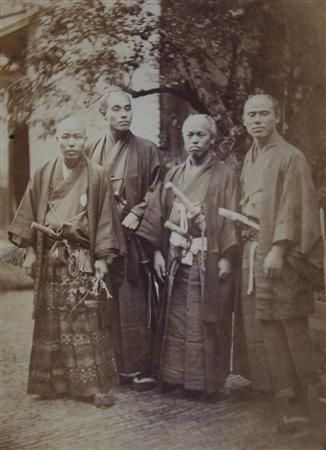
Some members of the Japanese embassy sent to Europe by the Tokugawa Shogunate as they traveled through Utrecht, Holland (1862). The second person on the left is Fukuzawa Yukichi who acted as one of the two translators. The Japanese mission was led by Shibata Takenaka. Photo Wikipedia.
Because the Japanese delegation felt that at this world fair their country has been inappropriately represented
this feeling of discomfort should have encouraged them to wish to have their own pavilion in the future Universal Exhibitions of Paris of 1867, 1878 and 1889. Indeed, Japan sent delegations to all these three international fairs. And, perhaps, during these Parisian universal exhibitions could have occurred the first encounter between a Venezuelan and a Japanese. Because, with all certainty, the Venezuelan brothers Marcano Echenique visited all these three exhibitions.
Now, we can almost be sure that the Venezuelan brothers Marcano Echenique visited these three exhibitions. In 1867, Gaspar Marcano (Caracas, 1850 — Paris, France, 1910) was a medical student in Paris (and, by 1878, he would become the first foreigner to occupy an official position at the Faculté de Medecine in Paris; by winning in a competitive examination, he became External and Internal to hospitals, and, later, he won the position of Head of Clinic at the Hôtel-Dieu hospital in Paris). His older brother, Vicente Marcano (Caracas, 1848 — Valencia, Carabobo State, Venezuela, 1891), was a student of industrial science at the École Centrale in Paris and a chemistry student being privately tutored by the great Alsatian chemist Adolphe Wurzt (1817-1884). These two brothers keen on science and the arts would not have missed the 1867 Paris Universal Exhibition on Champ-de-Mars. And, perhaps, there, on the grounds of Champ-de-Mars, during the second Parisian universal exhibition, could have happened a first encounter between a Venezuelan and a Japanese.
So far this investigation has no proof that they attended this international fair. But there are other possibilities.
To learn European and American culture and to understand the science and technologies being developed in Western countries, the Japanese government which resulted from the Meiji Restoration (November 9, 1867 — January 3, 1868; a political movement that returned the powers to the Japanese emperor) brought foreign experts to Japan, began the translation of Western textbooks, sent many of its leaders and some younger students to Europe and the United States to train in law, economics, science, medicine and engineering (for details of the numbers of students sent by Japan to the world see Chapter 8 – The Administration of Scientific and Cultural Affairs -, Numeral 4: International Exchange in the Fields of Science and Culture, in Japan’s Modern Educational System: A History of the First Hundred Years, 1980.)
Therefore, another possibility for a meeting between a Venezuelan and a Japanese may have occurred during the visit of these Japanese leaders and students abroad. For example, perhaps, Gaspar Marcano met Ryoun Takamatsu (1837-1916), the first Japanese doctor to study medicine in France between 1867 and 1868. Takamatsu was one of many members of the Japanese delegation to the 1867 Paris Universal Exposition. But, he remained in Paris to train in medicine at the Hôtel-Dieu hospital. Some encounters could also have taken place when a major Japanese delegation arrived in Paris in 1872 (if it happened it involved only Gaspar, as Vicente Marcano was in Venezuela during 1872-1873.) We are talking here about the so-called Iwakura Mission led by the Japanese statesman Iwakura Tomomi (1825-1883) who left Japan in December 1871 on a tour of the United States and several European countries (the mission was composed of 50 officers and 59 students,) and returned to Japan in 1873. This Japanese delegation was in France from December 16, 1872 to February 17, 1873 and produced a voluminous report of its activities (see Note 4.)
Now, since both nations, Venezuela and Japan, attended the Universal Exposition of 1879 and 1889, some encounters between a Japanese and a Venezuelan could have happened during the celebration of any of both events. Moreover, Vicente Marcano was the head (commissaire) of the Venezuelan delegation to the Universal Exposition of 1878. And, for the Universal Exposition of 1889, both countries, Venezuela and Japan, had their own pavilion.
However, for the 1889 Universal Exposition, due to disagreements with the Venezuelan government, Vicente Marcano resigned his position as one of the main leaders of the Venezuelan delegation and attended the event as a mere speaker from Venezuela. At this event, his brother Gaspar Marcano presented a pre-Columbian anthropological collection which months before had been gathered in Venezuela by a set of expeditions led by Vicente Marcano.
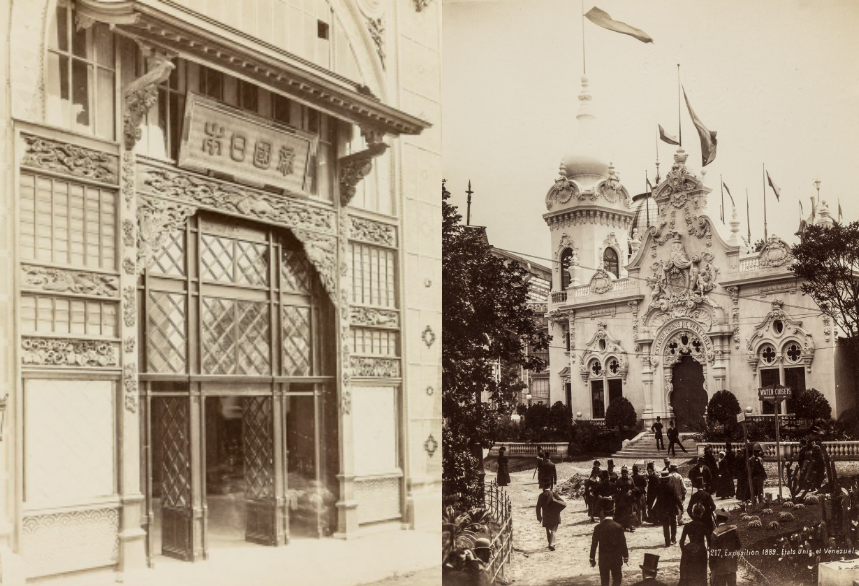
The pavilions of Japan and Venezuela at the Paris Universal Exposition of 1889. In the map below, next to the Eiffel Tower, notice the central location of the Venezuelan pavilion.
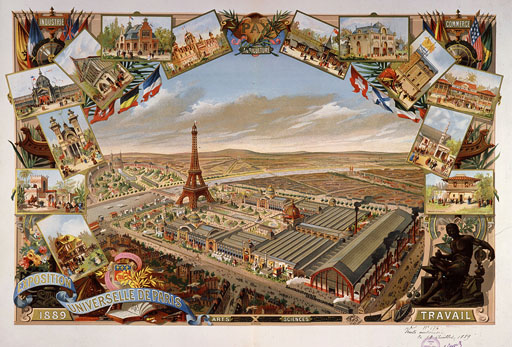
View of Exposition Universelle (Universal Exhibition), Paris, France, 1889. Photo Credit: The Art Archive / Musée Carnavalet Paris / Dagli Orti.
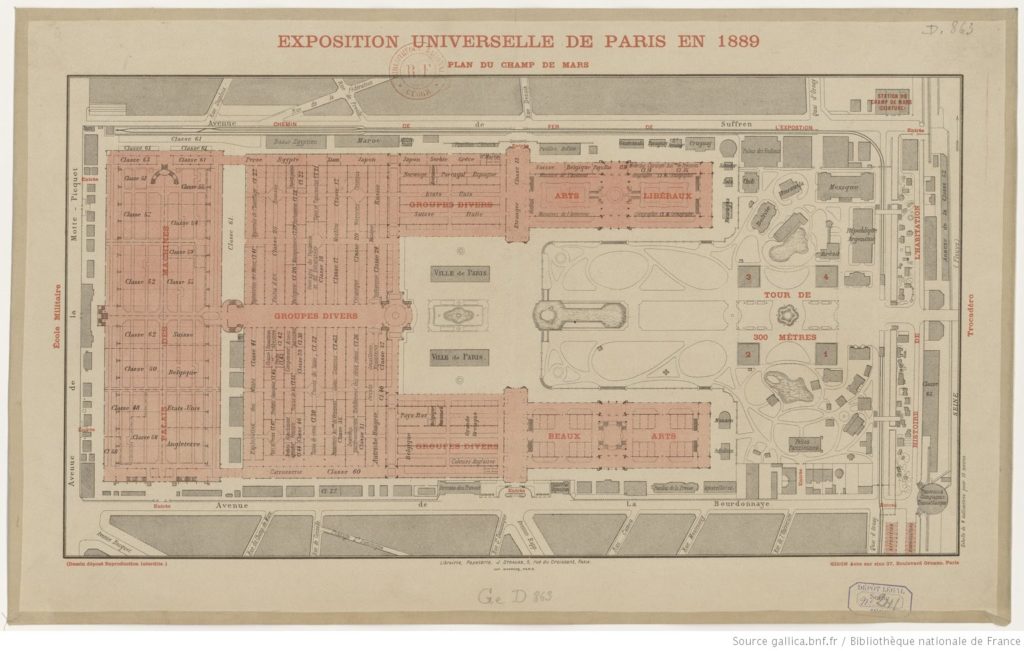
Floor plan of the Universal Exhibition of 1889. In the upper right corner of the floor plan, a ‘Venezuela’ label indicates the location of the Venezuelan pavillion on the lateral sides of Eiffel Tower. On the other hand, the Japanese pavilion is located toward top left side of the floor map (where it says “Groupes Divers”.)
Aner possibility for an encounter between a Japanese and a Venezuelan could have occurred in the French medical milieu since besides Ryoun Takamatsu many other Japanese studied medicine in Europe, and, by 1878, Gaspar Marcano was affiliated with the Hôtel-Dieu in Paris. Presently, we have no details of the Japanese who studied medicine in Paris (we do have details of the 48 Japanese who studied medicine in Strasbourg, Alsace). Finally, we must also remember that Vicente Marcano was a disciple of the great Alsatian chemist Adolphe Wurzt, born in Strasbourg, who at that time, was the dean of the Paris Faculty of Medicine (1866-1875).
Did the Marcano Echenique brothers meet a Japanese national in Paris? We do not yet know. Our intuitions need now to be validated by the historical record.
(4) The Author and Japan
In a celebratory mood because of the forthcoming 80th anniversary of bilateral relationship between Japan and Venezuela, I would like to insert here a personal note about my early interest in Japan and my own “bilateral relationships with Japan.”
My interest in Asia began timidly during the early eighties. One of my first tasks, in 1982, when I arrived in the San Francisco Bay Area to study at UC, Berkeley, was to look for a suitable bed for my rented Blake Street apartment in Berkeley. While shopping around, at The Golden Nagas, on Geary Blvd., San Francisco, I discovered something called a futon (布団, a traditional Japanese folding bed). And, from that day until today, I sleep on one (my Venezuelan futon was made by Ouroboros.) Shortly thereafter, I discovered Asian cuisine (especially, miso and tofu), green tea, sake, and Sapporo beer. Although I already knew something about Japan from watching Akira Kurosawa’s films (1910-1998) (Seven Samurais, Rashomon, and Dersu Urzala, among others) and the great Japanese actor Toshiro Misfune (1920-1997), the truth is that, back then, I did not know much about Japan.
In 1986, I returned to Venezuela. After some period of time, whose length I cannot specify today, at two of Caracas major bookstores (Suma and Tecniciencia), I discovered the novels by Yukio Mishima (1925-1970) (Mishima is the only Japanese novelist I have read in Spanish). Then, in 1988, on a return trip from New York City, I brought back with me several books by Yasunari Kawabata (1899-1972), and others by Jun’ichirō Tanizaki (1866-1965). Soon, I developed an interest in Zen Buddhism, Wabi-Sabi aesthetic philosophy, and, later, Chinese Taoism. Such interest led me to study Tai Ji Quan (太極拳) with Shifu Thayde Aguilera, and Shiatsu massage with Juan Canache who, in the 1960’s, had studied Shiatsu in Europe when the first Japanese masters of this art came to the West to teach.)
But, in a pre-Amazon era before Internet, living as I was in Venezuela, it was not easy to learn about Japanese literature while fulfilling my duties as a field geophysicist working for a Venezuelan national oil company (Maraven). Therefore, at that time, I knew very little about other Japanese authors. However, I did have the time and the money to try Japanese cuisine at the, then, famous Japanese restaurant in Caracas called Avila Tei (and to taste its famous dessert: fried green tea ice cream). But, in 1989, a visit to a bookstore at the Ateneo de Caracas put into my hands the issue No. 90/91 of the Spaniard magazine ‘Quimera,’ which included 30 pages dedicated to “current Japanese literature.”
By reading Quimera I learned about such authors like Natsume Soseki (1867-1916), Osamu Dazai (1909-1948), Ryu Murakami (born 1952), Kobo Abe (1923-1993), Kenzaburo Oé (born 1935, Nobel laureate in Literature 1994; and, I am very sorry to say, I have not yet read any of his novels), and Kazuo Ishiguro (born in 1954, and winner of the 2017 Nobel Prize in Literature). But in Quimera, my biggest surprise was to discover the Japanese female writers: those of antiquity, like Murasaki Shikibu (c. 973 or 978 – c. 1014 or 1031) and her Tale of Genji (years later I read an essay, written in 1963, by the great Japanese physicist Hideki Yukawa (1907-1981) who writes that, if he had to choose only one figure in Japanese history to represent the whole of the Japanese nation, then he would doubtless choose Murasaki Shikibu); Sei Shōnagon (c. 966-1017 / 1025) and her “Makura no shōshi” (The Pillow Book); and the modern writers Fumiko Enchi (1905-1986), Kuniko Mukōda (1929-1981), and the poetess Akiko Yosano (1848-1942) and her sensual tanka poetry – a Japanese style of poetry in short verses – collected in Miradegami (translated in English as Tangled Hair, 1901). Years later, I must add, I learned about Banana Yoshimoto (born in 1964) and her famous and entertaining book, “Kitchen.”
And this is how, in 1991, with a burning passion for learning about Japanese culture, I signed up to study Japanese in Caracas. However, my Japanese studies were soon to be interrupted. In 1992, I received a scholarship to go to China to study Mandarin Chinese and Chinese culture. Thus, I abandoned the study of Japanese culture and its language.
However, in Beijing, during my stay of almost three years, I made many Japanese friends (especially Kiyoshi Sasaki and Mami Yamashita) and I was able to get closer to the ways of being of the Japanese. And, later, in 1999, during my master degree at the University of Southern California, Los Angeles (MBA, with concentrations in Asia-Pacific business), there were ten Japanese classmates in my cohort. Among them my good friend Hiro (Hiroyuki Ishizaki) and Peter (Yohtaro Izumi). With Peter, my Korean classmate Phoenix (Hyeoung-Tai Park) and Daniel Killpack, together, in 2000, we traveled to Tokyo for our international consulting project for Newport Ltd. (owned by Kevin McAuliffe). It was my first time in Japan (although earlier, in January 1995, during a quick stopover on a return trip to Venezuela from China, I had set foot at Tokyo airport).

The author and his USC IBEAR MBA classmates shopping in Tokyo (from the left, Kaori Murakami, the author, Daniel Killpack, Peter, Andru Subowo, Marc Rogivue, Sabena Kamula, and Craig Ninomiya).
Despite all the Japanese literature I had read and my friendship with several Japanese, experiencing Tokyo (seeing Japanese in action on the streets of Tokyo and working in their companies) was a big surprise. In a Japanese bar, which to my surprise offered a selection of Venezuelan rums, I discovered, and got enchanted by, the music of Chie Ayado (at this bar they were playing over the song “I Only Have Eyes For You “; I asked who the Black woman singer was, but I was told that the artist was not Black but that, in fact, she was a Japanese woman).
Now, roll back to 1998, a peculiar thing happened to me on that year. I had gone on a short vacation to a peaceful place in the Venezuelan Andes called Hacienda Posada El Tao, in La Azulita, Mérida State. Suddenly, while walking down a quiet country road, I spotted something unusual on the horizon. It was a view that my eyes could not believe: two Asian looking girls were walking toward me. Mind you, there is no Asian tourism in Venezuela, or so I thought.
These two girls were in fact two Japanese tourists in Venezuela: Junko Takao and Kimiko Watanabe. After spending another day in La Azulita, they traveled to Canaima in southern Venezuela. And, after a short stay there, and a visit to Los Roques island, they both returned to Caracas. The day before they left for Japan, they lodged at my place for a day. In 2000, during my visit to Tokyo, I was able to meet them again.
Currently, every other semester, at the Faculty of Sciences of the Central University of Venezuela, I teach a course called “Topics in Cultural History of Science.” For some time, I have been contemplating an idea of teaching in this course about development of science and technology in Asia. Thinking that there could be lessons for Venezuela in the way that Japan appropriated the science and technology developed in the West, for the 2018 edition of this course, I decided to focus on Japan (my decision was also influenced by the forthcoming celebration in 2018 of the 80th anniversary of bilateral relations between Japan and Venezuela, and the 90th anniversary of Japanese emigration to Venezuela). Therefore, I selected the following topic: “Japan: Nature, Society, Science, and Technology” (course announcement in Spanish).
In this course, together with my students, I plan to explore the Japanese concept of nature, Japanese scientific thought, the development of science and technology in Japan, how Japan appropriated Western organizations and institutions, and the science and technology developed in the West, and search for lessons that could be applied to a country like Venezuela. As José Luis Cordeiro said it (in Spanish): “Japan and Venezuela are two complementary economies.” And, of course, I will include a class session to study the contributions of Japanese scientists in Venezuela and of Venezuelan scientists and engineers in Japan.
With the design and development of the syllabus for this new course and with the NIHON VES research line, I am very excited to have rekindled my interest in Asia and, in particular, in Japanese matters. Politics aside, the year 2018 should be a stimulating and provocative year. I look forward to it.
Conclusions
This has been a long but necessary historical journey. Through the emigration of nationals of both countries, we have placed in context the subject of the bilateral relations in science and technology between Japan and Venezuela. Thus, we believe that we have justified and laid the foundations for the NIHON VES research line of VES Project. This new research line will be executed to the extent that we can manage to secure the necessary funding.
It has been an interesting, though incomplete, journey through the history of emigration of Japanese to Venezuela and Venezuelans to Japan. Few things were left out. For example, nothing was said about who was the first Venezuelan to emigrate to Japan. Perhaps the first Venezuelan to land on Japanese soil was the Venezuelan Ambassador who died in office (Francisco Fraino Mirabal), or maybe not. This is a topic that needs investigation. Who could have been the first Venezuelan to witness the ephemeral sakura zensen (the cherry blossoms advance between March and May, which starts on the island of Kyushu at the end of March and, then, moves northward reaching Hokkaido by May)? Nor did we say anything about the Japanese relations with the metal industry (steel and aluminum) in Venezuela.
We have only sketched the contours of this hidden garden of cherry and orchids. Did you enjoy this trip? If you have arrived here: Thank you very much! And, if you also want to support VES Project, and its NIHON VES research line, it would be fabulous, and we will be deeply grateful!
In an old Japanese poem, we found a stanza that says “Mata kemu kagiri“, which literally translates “Till the utmost limit of my life.” This stanza seemed a suitable phrase for those of us who are forced to experience and endure the rudeness of times in Venezuela.
Waga inochi わがいのち
Mata kemu kagiri またけむかぎり
Wasureme ya わすれめや
Iya hi ni ke ni wa いやひにけには
Omoi masu tomo おもひますとも
(Anonymous Japanese poem found in the book Manyōshū)
This poem has been translated into English as:
Until life goes out
Memory will not vanish
But grow stronger
Day to day.
Acknowledgement
We gratefully acknowledge the help of our friend Hiroyuki Ishizaki with some of our online searches in Japanese and with the Hiragana aspects of Japanese poems.
VES Project is an independent research project that needs funding to continue researching and writing the life stories of the Venezuelan STEM migration. If you like VES Project and want to support it, you can use PayPal to make a donation by clicking the DONATE button below. THANKS!
NOTES
(1) Literature needed to understand the historical facts of Japanese immigration to Venezuela and the issues concerning the establishment of bilateral relations:
Delgado González, Antonio José. “La efímera presencia japonesa en Ocumare del Tuy durante la Segunda Guerra y Posguerra Mundial.” Tiempo y Espacio, no. 65, enero-junio (2016): 49-61.
Molina Medina, Norbert. Venezuela-Japón: una historiografía insospechada sobre sus relaciones diplomáticas. Universidad de los Andes, Centro de Estudios de África, Asia y Diásporas Latinoamericanas y Caribeñas” José Manuel Briceño Monzillo”, 2013.
Molina Medina, Norbert. Historia de las relaciones diplomáticas Venezuela-Japón:(1938-2008). Universidad de los Andes, Centro de Estudios de África, Asia y Diásporas Latinoamericanas y Caribeñas” José Manuel Briceño Monzillo”, 2012.
Noguchi, Shigeru. “Historia de los inmigrantes japoneses en Venezuela antes de la Segunda Guerra Mundial.” Humania del Sur 5 (2008): 27-42.
Federación Nikkei de Venezuela: Trayectoria de los 80 años de la colonia japonesa. 1928-2008. Caracas, Federación Nikkei de Venezuela, 2008.
Venezuela – Japón: 60 años de relaciones. Caracas, Ministerio de Relaciones Exteriores de la República de Venezuela – Embajada de Japón en Venezuela, 1998.
Noguchi, Shigeru. Historia de las relaciones bilaterales entre Venezuela y Japón antes de la Segunda Guerra Mundial. Caracas, Universidad Católica Andrés Bello, 1995.
Tarchov, Valentina. Esquema histórico de las relaciones venezolano-japonesas 1910-1942. San Cristóbal, Universidad Católica del Táchira, 1988.
(2) The reference is: Serrano, José A. “La microscopía electrónica en Venezuela: origenes y desarrollo.” In La microscopía electrónica en Venezuela: orígenes y desarrollo. Universidad de los Andes, 2010.
(3) The interview with Professor Takeuchi appears in the article, Forjadores del desarrollo de las matemáticas en Colombia: Yu Takeuchi. 50 años formando matemáticos en Colombia, Clara Helena Sánchez, Lecturas matemáticas, Vol. 30 (2009).
(4) These activities are described in: The Iwakura Embassy, 1871-1873: A True Account of the Ambassador Extraordinary and Plenipotentiary’s Journal of Observation Through the United States of America and Europe. 5 vol., KUME Kunitake. (The Japan Documents, 2002). A summary of the activities of the Iwakura Embasy can be read in: Kunitake, Kume. Japan Rising: The Iwakura Embassy to the USA and Europe. Cambridge University Press, 2009.
ABOUT THE AUTHOR:
José G. Álvarez Cornett (Twiter: @Chegoyo)
Member of COENER, the “Physics and Mathematics for Biomedical Consortium“, and the American Physical Society (APS). Alumni Representative before the School of Physics Council, Faculty of Science, Central University of Venezuela.
@ Chegoyo 2017
